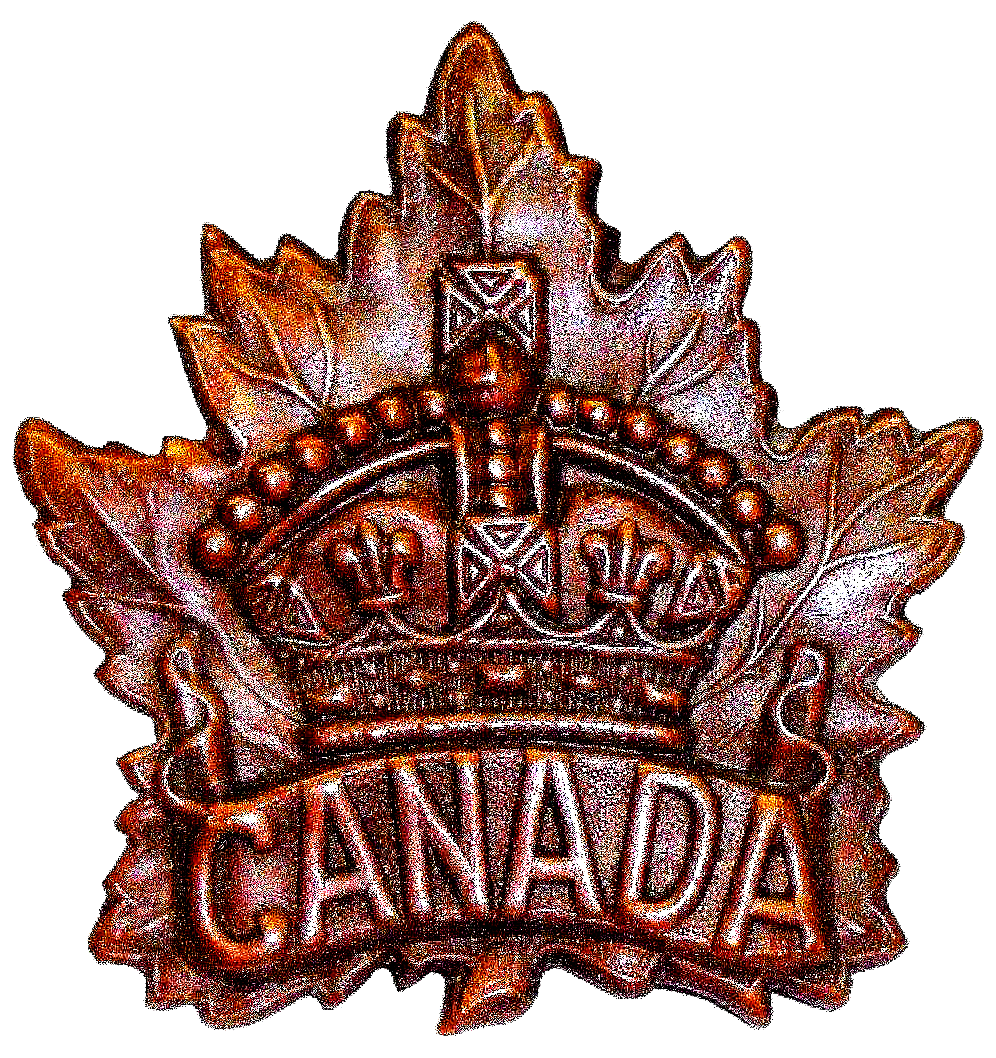
OPCMH
ORGANIZATION
for
PRESERVATION
of
CANADIAN
MILITARY
HERITAGE |

OPCMH
Visitor No.:
1493413
since
2015-03-21
| |
HISTORY OF WORK POINT BARRACKS
by Jack Bates
PART 5 — 1919 to 1939
1920
Daily Colonist
January 23, 1920
CLANCY WAS MEMBER OF PRINCESS PATS
Boston. Jan. 2 - A gunman who killed patrolman William Clancy, who objected to his actions at a dance in the Charleston district today, was still at large this afternoon.
The police held 300 dancers, women and men for several hour’s examination, eventually detaining four men for further enquiry, but it is believed the man who shot the officer had escaped.
Officer Clancy was a member of the Princess Patricia’s Canadian regiment, had gained decorations for bravery in action, and was shot down in the centre of the dance floor after he had admonished the man who had disobeyed his orders to stop smoking.
A patrolman who was present as a guest drew his revolver and held the crowd back from the door. Many however, fled by a rear exit and by fire excapes. Clancy’s assailant probably being among them.
Unfortunately I cannot find a record of him with the PPCLI.
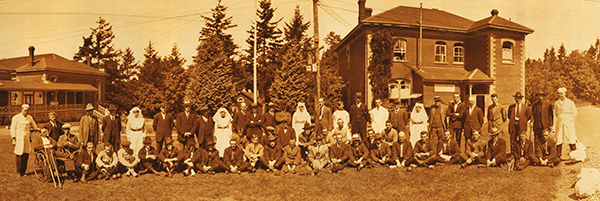 |
Esquimalt Military Convalescent Hospital 1920
... run cursor over photo to zoom image ... |
COLONIST
April 13, 1920 (4)
ESQUIMALT’S NAVAL BASE
A more specific announcement than any yet given is due regarding the Federal Government’s policy respecting the naval dockyards at Esquimalt and Halifax which are now in process of being demolished. In 1919 when these dockyards were “taken over” from the Admiralty they were “taken over” to be held in trust during such time as the Canadian Government wished to maintain them for the purpose of naval policy. Such a transfer, in trust, was provided for by an Imperial act of October 20, 1909, whereby it became lawful, by order in council, to vest any store, yard, magazine, building or other property in any British possession. This act is called The Naval Establishments in British Possessions Act and shows the Federal Government holds the Esquimalt and Halifax dockyards “in trust,” and, according to the terms of the transfer, “for the purpose of naval policy.”
The people have the right to learn if it is the intention of the Federal Government to return these naval bases to the Imperial Government, and if so if the latter purposes to re-establish them as British naval bases. The Government of Canada can hardly propose to use Esquimalt harbor and dockyard for fishery purposes and consider that thereby it fulfils the terms of the contract by which it took over the administration of the naval base. Because of the terms of the contract more light should be shed on the present demobilization policy. It is a matter in which both the British Government and people, as well as the Canadian people, are interested. During the present session in Ottawa a statement, that will tend to reassure the people of the Pacific Coast Province, should be made.
September 8, 1920
GENERAL MORRISON’S INSPECTION TOUR
Commanding Officer of Canadian Artillery Force in Great War Now in City
Has Had Distinguished Career
On his annual trip of inspection, Major General Sir Edward Morrison, K.C.B., arrived in Victoria yesterday and today will commence an inspection of the forts of artillery personnel of Esquimalt. Last evening he was a guest of members of the G.W.V.A. at the gathering at the Princess Theatre and tonight he will be the guest of the Artillery and Permanent Force officers at Work Point Barracks.
General Morrison stated last evening that his present visit possessed no particular significance other than the customary inspection which is made annually. Concerning the dispatch from Vancouver that a company of the Princess Patricia’s Canadian Light Infantry, is due at Work Point barracks from Winnipeg, General Morrison stated he was not aware of the matter, but as he has been away from Ottawa for some time now, the move, if it is to be made, apparently was decided upon since he left Ottawa.
General Morrison has had a distinguished military career. He served through the South Africn War, where he gained the D.S.O., and in the Great War he served with great distinction with the Canadian forces.
Major Wendell Shaw, who was with General Morrison from the days of Valcartier, speaks of him as “a man’s man.” Starting off as senior Artillery Brigadier, commanding the First Brigade, C.F.A., he won the highest point of achievement, that of C.R.A., Canadian Corps. Dogged to a degree, brilliant in his administrative capacity, thoroughly au fait with artillery tactics, he went up the ladder by leaps and bounds. At the second Battle of Ypres, Majoe Shaw states, and throughout the war, General Morrison showed the quality which his men loved and admired, that of “nerve.”On several occasions, in exposed positions, he personally directed the fire of batteries and always with entire disregard of personal danger. His presence here will be welcomed by his old officers and men.
ESQUIMALT MUNICIPAL COUNCIL MINUTE BOOKS
November 15, 1920
Letter was read from the Chief of Police reporting the occurrence of a fire in the stable rented by W. Yerrill and owned by the San Juan Mining Company. The Chief stated that thanks to the assistance rendered by Soldiers from Work Point Barracks under command of Col. Russell (Lt.-Col. Russell, CB, DSO, Sr. Engineer Officer, District 11) the fire was prevented from spreading to the main buildings.
November 26, 1920
PRINCESS PATS ARE HERE FOR GARRISON
Detachment of Officers and Men of Regiment Arrive
To Be Quartered at Work Point
A detachment of the Princess Pats who are to be stationed at Work Point Barracks have arrived in the city from London, Ont., under the command of Lieut. Col. Codville, M.C.
Altogether including officers and other ranks, the addition to the strength here will be sixty-four men. A number of the recruits are staying at hotels temporarily until arrangements are completed at their new quarters. Sergt. Lennox, Mrs. Lennox and family, Sergt. Spanton, Mrs. Spanton and family, and a number of the men are registered at the Douglas Hotel.
The commanding officer, Lieut. Col. Codville, is a regular, having formerly belonged to the Royal Canadian Dragoons, while Major Clarke, who came here in advance to make the necessary arrangements for the men, is one of the few remaining original officers of the famous Princes Patricia regiment.
Victoria Times
November 27, 1920
PRINCESS PATS HAVE ARRIVED FROM EAST
Company is to be Stationed at Work Point Barracks – Many Veterans
In command of Col. F.H.M. Codville, M.C., of London, Ontario, a company of the Princess pats arrived in Victoria on Thursday afternoon. The company arrived in full service kits and proceeded to work Point barracks, where they will be stationed.
The “Princess Pats” now have only three companies of a peace strength of about 150 men per company. Two companies are at Winnipeg, and the third company will be permanently located at Victoria. Col. F.M.H. Codvile, M.C., formerly commandant of Baxhill School, is in charge of the detachment, and second in command is Capt. J.S. Woods, M.C.
Among the men a large sprinkling of overseas decorations were noted. One sergeant has the D.C.M., M.M., 1914-15 Star, and the usual campaign ribbons. Practically all the men are young, but wound stripes are not unusual. The company is not up to strength, and the officers intimated that probably they would do some recruiting in the Province after they have settled down in their new quarters at Victoria.
Daily Colonist
December 20, 1920
PRINCESS PATRICIA COLORS SENT HOME
Winnipeg: Dec. 23 – The colors of the Princess Patricia’s Canadian Light Infantry, carried by the Regiment throughout the war, have been sent to the Colonel in Chief, Lady Ramsay, formerly Princess Patricia of Connaught, at Clarence House, for a reproduction which she will pserconally make.
While being carried in action furied, the colors were hit by a bullet, which penetrated them five times, and on another occasion, the staff was struck by shrapnel. So worn were the colors when sent to Lady Ramsay that they could scarcely hold together.
The colors will be returned to the famous Regiment, now at Winnipeg.
1921
My father, Alfred Arthur Bates, enlisted in “B” Company of the PPCLI on January 25, 1921, at Esquimalt’s Work Point Barracks. He was to serve at the barracks with “B” Company until posted to Currie Barracks in Calgary Alberta, on November 20, 1937, returning to Work Point August 14, 1945.
Now that “B” Company of the PPCLI is established at Work Point, daily routines, much a carry over from the disciplines of the war, kept everyone busy and occupied. Bugle calls were much the order of the day, likely an extension as well from the war years. Quite independent from Victoria, the barracks had its own community presence and culture. It functioned as a small city, contracted out for supplies and works, performed its traditional military duties, handled its “domestics” internally, but also hosted and participated in many local functions. It provided guards of honor for events, parades and visitors, firing parties for civilian and military funerals, adding a respected military fabric to the community and available if needed, to “aid the civil power.” A number of the married men and families eventually lived in civilian houses outside but close to the barracks.
Not much is recorded for the “between the wars” period, an example of the daily routine and duties in the early twenties is as follows, signaled by bugle calls:
Revielle – 5:30 am (summertime) and 6:30 am (winter), sick call, physical training, breakfast, parade, roll call and inspections, orderly room, parade, defaulters, supper, retreat, sunset, fire picquet, evening, last post, lights out, with some intermediate first calls mixed in. A possible 20 calls in a day, including “ pay parade” and Commanding Officer’s reception. There were two duty buglers a day, occasionally an “Alarm” call in the night was required, and perhaps a “Fire” call.
There was also guard duty, a sergeant, a corporal and six men per day, fire picquet, canteen, and orderly room personnel on duty. Needless to say, all the duty personnel were put to the test at one time or another!
Budgetary cutbacks, lack of equipment and kit and low recruitment, were features of the post war Permanent Active Militia (PF), as well as periodic reductions in personnel strengths of units. Local summer camps and training of the Non Permanent Active Militia did maintain itself for most years, on slim budgets, as well as personal training and education with an eye to individual advancement in rank. They all “got on with it”, even through the depression years.
Patricia’s were concentrated at Sarcee Camp, Alberta, to carry out battalion training on only four occasions during the nineteen years (1927 and 1930 I have photos). Each summer, “B” Company went to Heal’s Camp and other locations on Vancouver Island during the same period.
However, in the mid thirties, once the idea and threat of war was realized, spending and training increased, units were expanded, and the military again had more presence. Quite a number of the WW 1 veterans in “B” Company, were sent out into the cities and military camps of British Columbia and Alberta to organize and train recruits in preparation for WW 2.
Other units at Work Point in 1921 were HQ Military District 11; 3rd Fortress Company RCE; Canadian permanent Machine Gun Brigade – A Company; No. 11 Detachment RCASC; C.M.G. Brigade (11th); Royal Canadian Permanent Army Pay Corps; RCAMC; and the Military Hospital.
No 5 Company RCGA, 11th Fortress Signalling Co., 12th Siege Battery CA, 58th Battery CFA and 1Bn 16th CEF were at the Bay Street Drill Hall, while the RCOC was at Signal Hill.
 |
B Company PPCLI Esquimalt 1921
... run cursor over photo to zoom image ... |
1922
The Royal Canadian School of Artillery was established, utilizing Macaulay Point as its base, in 1922. The Macaulay Point Battery was the only coast artillery battery within the Victoria – Esquimalt fortifications complex which existed continuously throughout the whole 1878 – 1956 story line period.
No. 11 District Works Detachment R.C.E. was formed from 3 Fortress Company, R.C.E.
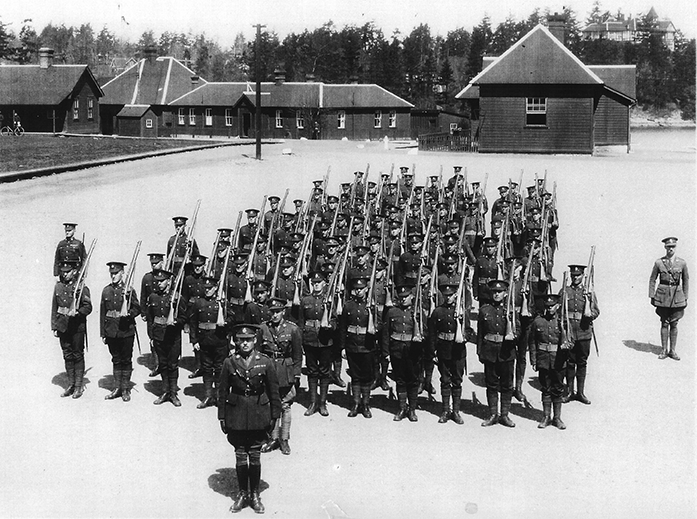 |
B Company PPCLI on Parade at Work Point Barracks 1922
... run cursor over photo to zoom image ... |
COLONIST
July 23, 1922 (18-19)
VICTORIA BATTERY, GARRISON ARTILLERY
Organized 18th July, 1878 - 44th Anniversary Last Wednesday
This article is two pages of the history of the Victoria Battery - Garrison Artillery, organized on the 18th of July, 1878, and is the initial artillery battery perpetuated by the 5th (BC) Field Regiment RCA, here in Victoria. The photographs can be seen enhanced on the “Oak Bay Chronicles” web site, hosted by Peter Grant. Search under “Charles Dupont.”
The article was occasioned by the 44th anniversary of the founding of the Victoria Battery and is very precise, an excellent read in the language and spirit of the day. Included are photos with captions of Finlayson Point, Beacon Hill and Macaulay Point camps by R. Maynard.
Last Wednesday, the 19th of July, is the birthday of the 5th regiment, C.G.A., and marks the 44th anniversary of the organization of the Victoria Battery of Garrison Artillery, which unit was later enlarged and on several occasions reorganized until it was given the designation of 5th (British Columbia) Regiment of Garrison Artillery.
Militia General Order (No. 17) dated 19th July, 1878, and published in The Canada Gazette of 20th July, 1878, read as follows: “The formation of a Battery of Garrison Artillery at Victoria is hereby authorized, to be designated the Victoria Battery of Garrison Artillery. To be Captain, provisionally: Charles Thomas Dupont, Esq. To be 1st Lieutenant: David Garrick McNaughton, Gentleman, G.S. To be 2nd Lieutenant, provisionally: Arthur William Jones, Gentleman.”
ARTILLERY CAMP, BEACON HILL, 1884
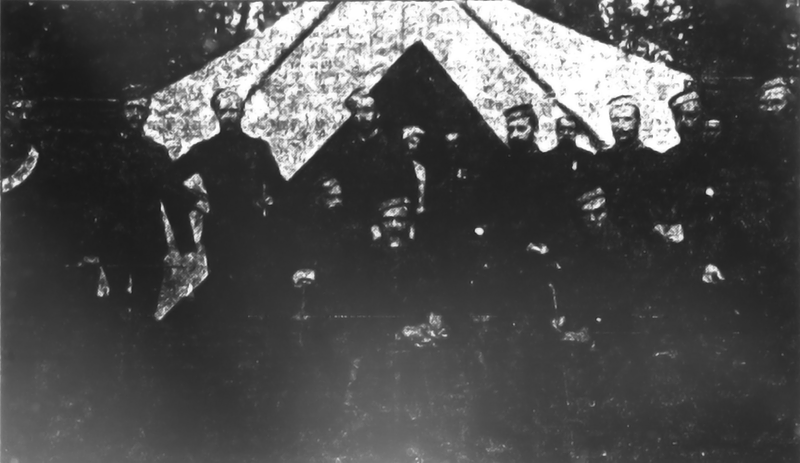 |
First Row, sitting, from left to right:
Lieut. A.G. Gamble, Major C.T. Dupont, Capt. R. Wolfenden.
Standing, left to right – Capt. J. Nicholles, Capt. W.H. Dorman, Capt. A.W. Jones, Capt. N.P. Snowden, Capt. J.L. Raymur, Capt. W. Shears, Capt. E.G. Prior, afterwards Lt.-Col. And O.C. and also Lieutenant-Governor of British Columbia.
Photo - R. Maynard |
This camp was located to the east of the hill, about where the park nursery is now located.
Victorians are justly proud of its artillery regiment which has included in its membership at various times a majority of the most respected citizens of Victoria and has had for commanding officers such distinguished men as General Sir Arthur Currie, Lieut.-Col. E.G. Prior, late Lieutenant-Governor of British Columbia, Lieut.-Col. F.B. Gregory, now Judge of the Supreme Court, and other men of note in the civic life of the country.
The present officers are now collecting data for a comprehensive history of the regiment, but this is a task that will naturally take considerable time to complete. This article, which has been prepared in view of the 44th anniversary of the regiment last week, will be limited to an account of the circumstances leading up to the organization of the first Victoria Battery and a history of the unit under its first Commanding Officer, Major C.T. Dupont.
ORIGIN DUE TO RUSSO – TURKISH WAR
Although several years prior to 1878 Lieut.-General Sir Edward Selby-Smith, commanding the Canadian Militia, had recommended certain protection for British Columbia Coast towns, no action was taken by the Government until certain happenings during the Russo-Turkish War, in the years 1877 and 1878, brought home to the Ottawa authorities the need of coast defences on the Pacific.
War was declared between Russia and Turkey in April, 1877, and for a time it seemed probable that other European powers would become involved in the conflict. When the Russians in their advance against Turkey had reached and occupied Adrianople, Great Britain, realizing that the fall of Constantinople, which was threatened, would be a menace to the Indian Empire, notified Russia that she would look with disfavor upon her occupation of that city. At the same time the British fleet, which was in Besika Bay, near the mouth of the Dardanelles, received orders to proceed through the Straits and Sea of Marmora to the Turkish Capital, ostensibly for the protection of British life and property there. Relations between Great Britain and Russia were strained almost to the breaking point and there was every prospect of Britain entering in war with Russia.
EFFECT OF WAR IN CANADA
In Canada there was considerable interest and excitement and offers of service in the event of war were made to the extent of raising in Canada several thousand men to serve in the British Army. These offers were as cordially received by the Imperial Government as they were loyally made, but, happily, these volunteer services were never required.
The excitement in Canada later increased when it became evident that a declaration of war by Great Britain would mean that Canada, from her position and surroundings, would in all probability be the first to feel the effect of the enemy’s assault after a declaration of war.
This situation was brought home by a two events, viz. : The sudden appearance in the Port of Ellsworth, State of Maine, only a few hours from St. John, N.B., of the Steamship Cimbra with a large body of Russian seamen and a cargo of heavy rifled guns on board, her undoubted object being to man and arm fast steamers to molest our shipping and lay waste our seaports.
The second event, referred to above, was the activity displayed by the Fenians, who, relying on the probability of Great Britain being fully occupied with Russia, were gathering in American centres for the ostensible purpose of making marauding descents on Canadian points.
PREPARATIONS FOR DEFENCE
To meet the emergency, the Militia Department took immediate steps to place the danger points of Canada in a state of defence. Arms and ammunition were served out to all corps of the militia along with the whole line of frontier, from Sherbrooke to Lake Huron, extending 500 miles. Guns and howitzers were place din certain positions along the shores of St. Clair River, Lakes Erie and Ontario, and on the River St. Lawrence, fitted with ship carriages, to arm steamers which were prepared to receive them. A detachment of artillerymen was held in readiness to man these guns, and several other precautionary measures were taken to prevent a surprise.
SITUATION IN VICTORIA
The events above described awaked the authorities to the need of providing some land defences at Victoria and Esquimalt. At this time Admiral de Horsey, with the major portion of the fleet which had Esquimalt for base, was cruising in South American waters, leaving H.M.S. Opal and gunboat Rocket as the only vessels to prevent possible raids against Victoria and other coast towns. When The Daily Colonist of February 9, 1878, reported the arrival in San Francisco of a Russian squadron of five vessels, the public excitement grew intense and the banks transferred their money and securities to Port Angeles for safety.
On February 16 a conference was held in Victoria, composed of representatives of the Provincial Government, the army and the navy. Capt. Robinson, senior naval officer at Esquimalt at the time, stated that he was in hourly expectation of receiving the news of England having declared war against Russia. He referred to the Russian gunboats at San Francisco, and explained that his only two boats available would be little us in case of attack. It was his opinion that an effort should be made immediately to provide land defences, and offered to lend Palliser converted 64 pdrs for two batteries, with instructors, if volunteers could be obtained, and hastily trained to man them. Lieut.-Col. Houghton, D.A.G. M.D. 11, concurred in this proposal, and on his request Capt. C.T. Dupont consented to undertake the organization of a volunteer battery.
CALL FOR VOLUNTEERS
Notices calling for volunteers were immediately posted on the bulletin board at the corner of Government and Yates Streets, known as Campbell’s Corner, on which notices of passing events of interest were hourly posted and read.
The following advertisement was also published in The Colonist the following day, February 17: “Persons desirous of enrolling themselves as a voluntary artillery corps are urgently requested to report themselves personally to the Deputy Adjutant-General of Militia at the Drill Shed, between the hours of 12 a.m. and 2 p.m. on Monday next, the 12th instant. (Sgd.) C.F. Houghton, Lt.-Col., D.A.G. of Militia.
At this time the cable between Victoria and the Mainland was broken, and therefore Captain Robinson arranged to have his fastest launch across the Straits to bring him immediate news of the declaration of war. He also had posted a signal corps at Race Rocks to signal the approach of any war vessel.
ARRIVAL OF RUSSIAN GUNBOAT
At about 10 a.m. on February 18 Captain Dupont, who was at the Dockyard, Esquimalt, seeing to matters connected with the guns and ammunition, was informed that race Rocks look-out had signaled a vessel of war coming up the Straits, and later as flying the Russian flag. Capt. Robinson was away at Government house, and as there was no telephone or tram car in those days, a messenger was sent on horseback to inform Capt. Robinson, but before that officer could arrive the Russian gunboat Craysser entered Esquimalt Harbor and came to anchor.
It was a considerable relief to Victorians when they knew that the Russian visitor had no warlike designs against this port. Capt. C.N. Naasimoff reported that he had come from Vladivostok, via San Francisco; that on his way northwards he had encountered very bad weather, with the result that he had lost a man overboard; had sprung a mast and had come in to refit. He expressed amazement on learning there was danger of war between his country and England, Vladivostok being out of the way of news, and next morning quite openly left the harbor.
BATTERIES AT BEACON HILL
In the mean-time the call for volunteers met with an enthusiastic response. Although at this period Victoria was a small town of only about 14,000 inhabitants, in three hours more than enough men had volunteered, and by the afternoon of the same day the laying of platforms was begun for a two-gun battery at Finlayson Point and a two-gun battery at another point in Beacon Hill, known as Victoria or Nias Point. The following day the guns on naval carriages and slides were placed in position by men of the navy and ammunitions supplied. In addition to the converted Palliser guns mounted at Beacon Hill, that had an effective range of little over 2,000 yards against a wooden vessel, Capt. Robinson had a more powerful gun mounted on the small island at the entrance to Esquimalt Harbor, to be manned by a naval crew.
FIRST DRILL PARADE
The first drill parade of this volunteer corps was carried out by detachments at the drill shed on the 20th February, as follows:
No. 1 detachment, under Capt. Croasdale, at 4 p.m.
No. 2 detachment, under Capt. Machell, at 6:30 p.m.
No. 3 detachment, under Capt. Dupont, at 8 p.m.
The following local item appeared in The Daily Colonist of the same day: “Volunteer Artillery Drill – The first drill of this corps will take place by detachments at the drill shed today. The commanders of the corps have all had experience in military matters. Capt. Croasdale is a Lieutenant of the Royal Navy, on the retired list; Capt. Machell held the rank of captain in the British army, from which he lately retired, and Capt. Dupont was an officer of the Victoria Rifles, Ontario.” (This is an evident mistake, as the Victoria Rifles were at Montreal, Que., not Ontario.)
CLOSE OF THE WAR
The war between Russia and Turkey was brought to an end by the signing of the Treaty of San Stefano, on March 3rd, 1878, and consequently immediate danger of attack against Canadian ports was dissipated. However, the Dominion Government was now awake to the necessity of making some provision for permanent defences on this coast, and Lieut.-Col. D.T. Irwin, Inspector of Artillery, was sent out to Victoria in the following May to supervise the work of construction of fortifications and to render assistance in connection with the training of the volunteer battery, which later was incorporated into the active militia on July 19th. (See copy of militia order at commencement of this article).
EXTRACTS FROM LIEUT.-COL. IRWIN’S REPORT
On my arrival at Victoria on the 27th May (1878), I reported to Lieut.-Col. Houghton, the Deputy Adjutant-General of the district, and with him on the same day attended the first muster of the Garrison Battery, under Captain Dupont, the Inspector of Land Revenue, and arranged for a systematic course of evening drills and lectures, to be held three times a week, under my instruction and supervision.
FIRST CAMP OF LOCAL ARTILLERY CORPS AT FINLAYSON POINT, BEACON HILL,
DATE ABOUT 1880
.png) |
From left to right – Capt. C.T. Dupont, O.C.; Capt. A.W. Jones, No. 2 Co.; Capt. R.G. Tatlow (attached), afterwards Provincial Finance Minister; Capt. W. Shears, Paymaster; Capt. J.L. Raymur, No. 4 Co., (present City Comptroller); Staff Surgeon Matthews; Capt. R.J. MacDonald, District Quartermaster.
The group of gunners in rear includes C.H. Kent, Chas. Rhodes, Geo. Anderson, Geo. Weiler, Ross Monro, afterwards Lt.-Col. And O.C. of the Regiment; A.G. Sargison, afterwards Major and second in command; Geo. Morrison and Wm. Trickey.
Photo - R. Maynard |
The camp was pitched alongside the grove of trees immediately in rear of the Finlayson Point battery. The remains of the traverses of this earthwork are still to be seen on the cliff overlooking the Straits. The photograph was taken looking north and shows that at this time Beacon Hill was bare of broom.
CHOICE OF SITES FOR BATTERIES
“Having placed myself in communication with Captain F. Robinson, H.M.S. Opal, the then senior naval officer on the station, I made with him and Lieut.-Col. Houghton a careful examination of the coast with a view to determine upon the best sites for defensive works.
“In this important duty I was afterwards assisted by a board of officers, detailed for this duty by Rear-Admiral de Horsey, Commander-in-Chief on the Pacific, and composed of Captain Redford, H.M.S. Shah; Captain Burrows, R.M.A., and Gunnery Lieut. Lindsay, H.M.S. Shah.
“The results of this careful examination have already been fully detailed in my previous reports on this subject, June 6 and July 3, 1878.
“It may be sufficient here to state that the plans proposed by Lieut.-Col. Blair were not found to be practicable, and it was found necessary, in order to defend with the fire of at least one gun all approaches to both harbors, to place ten pieces of ordnance in position at the sites shown in accompanying general plan (Plan V) and arranged as follows:
“Finlayson Point, 2 64-pr. R.M.L.
“Victoria Point, 2 64-pr R.M.L.
“Macaulay Point, 3-7-in, 6 1/2 ton R.M.L.
“Brothers Island, 1 8-in, 9 ton R.M.L., and 2 64-pr R.M.L.
“It may here be observed that the Victoria Point mentioned in the general instructions previously quoted has no existence except as a designation chosen by Lieut.-Col. Blair for a point close to Point Ogden, and the Victoria Point, as shown in accompanying plans, is a point nearly midway between Finlayson Point and Holland Point, and so designated by me, in default of any local nomenclature.
CONSTRUCTION OF BATTERIES
“The accompanying plans I to IV show on a sufficiently large scale the construction of the several batteries, the following details with reference to which may, however, be found useful:
“The second general nature of the works is that of sunken barbette batteries. The position of the sites being in all cases elevated, and close to the steep slopes leading to the sea beach, it was not found necessary to excavate a ditch in front, the earth for the traverses being more conveniently obtained in rear of the parapet, better cover in less time, and with more solid construction, being obtained by this arrangement.
“The guns are all mounted en barbette, it being necessary to command as extended an area of waterfront as possible.
MAJOR C.T. DUPONT
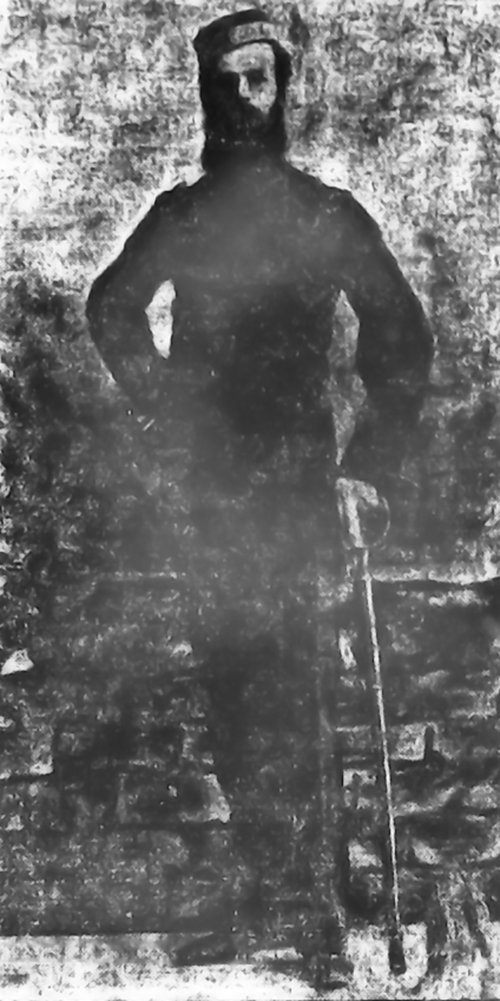 |
| Major C.T. Dupont - (Photo - R. Maynard) |
Who in 1878 was authorized to raise a Volunteer Artillery Corps in Victoria, and the first O.C. of the present 5th Regiment.
GENERAL REMARKS
“The actual work of excavating the batteries began on June 10 and was continued with only one day’s (July 1) intermission until August 30. “The working party was entirely composed of civilian laborers under the immediate control of a foreman. Their number averaged from 12 to 28 men, the men being paid by the day.
“With reference to the subject of manning the guns in these batteries, it will be observed that for this purpose the only means at present provided are the members of the Garrison Battery enrolled about the time of my arrival, numbering about fifty all ranks.
“Of this number about thirty attended the voluntary evening drills and lectures held on the average twice a week during my stay in Victoria. About twenty men are fairly proficient in gun drill and artillery exercises, and a class of about ten of the officers and probable non-commissioned officers who were able to attend occasionally at special afternoon drills, are capable of instructing at standing gun drill and elementary exercises.
“The battery is fortunate in being commanded by an officer of great energy and zeal, and also in possessing the services as instructor of Lieut. D.G. McNaughton, who obtained a first-class short course certificate from this school of gunnery in January, 1876, he being then a sergeant in the New Brunswick Garrison Artillery.
“With the exception of firing a salute from Macaulay Point Battery on the opening of the Provincial Legislature, the volunteers did not turn out for actual duty or perform any paid drills previous to my departure, a very general wish having been expressed to postpone their annual drill and competitive gun practice until their uniforms arrived.
VICTORIA BATTERY OF GARRISON ARTILLERY AT MACAULAY POINT,
JULY 29TH, 1878,
AFTER FIRING SALUTE ON OPENING OF PROVINCIAL LEGISLATURE
(Uniforms not yet issued)
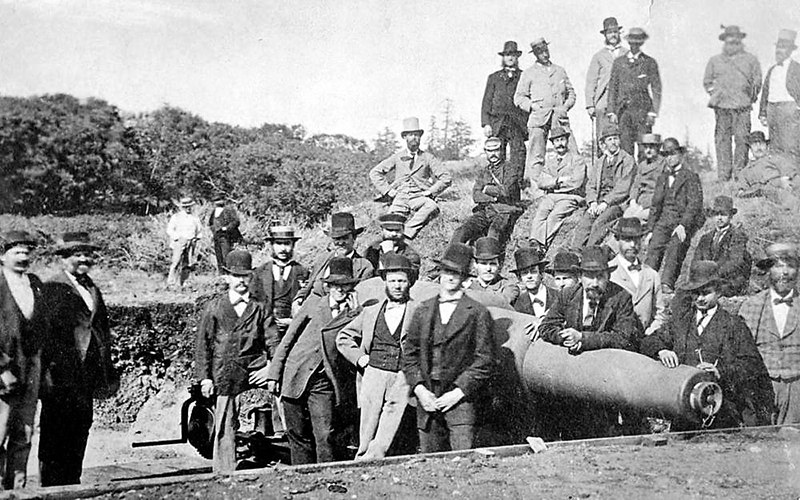 |
Samuel Bates, second from left;
G.W. Anderson, W. Trickey, W.O. Carter, in front of and leaning against gun.
In group of three standing at breech of gun – F.H. Hiscocks, in straw hat; Fred Miller, with hat to chin.
In group standing just behind gun –
Lt. C.M. McNaughton, of Seymour Battery, on left; Geo. W. Wynne next; Henry Spofford, head only showing; W. Lorimer, both arms on gun; Henry Horne, with hand on gun chase; Mr. Gregory, standing on right, with straw hat.
Sitting on hill, row of six – Capt. C.T. Dupont, on left; Lt.-Col. Irwin, in uniform; Clifford H. Cogan next; J.L. Raymur, in straw hat; First Lieut. D.G. McNaughton, on right.
Standing in back row – Second Lieut. A.W. Jones, second from left; Surgeon Matthews, second from right; Hon. A.C. Elliot, on right.
Photo - R. Maynard |
FIRST ANNUAL INSPECTION
The first annual inspection of the battery was made December 14, 1878, by the Deputy Adjutant-General of the district, accompanied by the Lieutenant-Governor. The parade state on that occasion was three officers and thirty-one other ranks. The following account of this inspection is taken from Lieut.-Col. Houghton’s official report for 1878:
“I returned to Victoria on the night of the 13th instant, and inspected the Battery of Victoria Garrison Artillery, under the command of Captain Dupont, at 3 p.m. on the 14th on Beacon Hill, on which occasion I was honored by the presence of the Lieut.-Governor, who was received with the usual honors, and inspected the men.
“Of the arms and clothing, it is needless to remark (all being perfectly new and paraded for the first time) further than that the clothing had all been well fitted and looked particularly neat. I may, however, here mention that the accoutrements in store were only sufficient for twenty men, and therefore a number of the men had to appear without them.
“After inspection, the battery marched to Finlayson Point Battery, where they fired four rounds of each shot and shell from the two 64 – pounder M.L.R. guns, there mounted, at a target anchored 1,100 yards from the battery.
“The guns were well served and the practice was remarkably good, none of the shots missing the target by more than three feet laterally, or, as I should judge, four feet perpendicularly, two of the shells actually bursting directly over the targets and within three to four feet of it.
“Captain Dupont commanded the battery, and his subaltern officers were in charge of their respective guns.
“Both officers and men acquitted themselves exceedingly creditably on the occasion and showed that they had not forgotten the training and instruction imparted to them by the able and zealous officer, Lieut.-Colonel Irwin, Inspector of Artillery, who spared no pains and shrank from no personal labor in order to bring the corps up to the highest possible standard of efficiency during his short stay in Victoria.
FIRING OF INTERNATIONAL SALUTE
Early in the following year, 1879, the battery was called upon to fire an international salute of twenty-one guns. The circumstances leading up to this incident deserve to be recorded.
The Victoria newspapers of February 16 published a petition signed by the American citizens of Sitka, Alaska, addressed to the commander of the British Naval Squadron at Esquimalt, stating that they were in imminent danger of being massacred by the Indians, and as they had no confidence in their own government coming to their rescue in time, begged the commander to send a war vessel to their aid. The petitioners, in concluding, paid a high tribute to the “Red Ensign” in going to the rescue of its citizens in all parts of the globe, and they expressed the hope that their request would not be delayed through international red tape.
The United States consul wired the Washington authorities the news of this unusual petition which had been brought to Esquimalt February 14 by Capt. Thorn, of the steamship California. Prompt action was taken, and on the evening of the 16th H.M.S. Osprey, Capt. A’Court, left Esquimalt for Sitka on the understanding she would be relieved as soon as possible by an American gunboat.
Almost six weeks later, on the morning of March 27, the United States corvette Alaska, on her way from San Francisco to relieve the Osprey, called at Esquimalt, and the Victoria Garrison Artillery Battery was called upon to return her salute as the only warship in Esquimalt, the gunboat Rocket, was commanded by a naval lieutenant who, according to naval ethics, was not eligible to return such a salute.
This duty came as a surprise to the Artillery unit, and to make things more interesting it was found that there were no cartridges with which to fire the guns. However, an express wagon was hastily dispatched to the Dockyard with a requisition for the necessary amount of gunpowder, with which Lieut. McNaughton, with the aid of a couple of gunners, made up a sufficient number of charges of 33 pounds each. The firing was successfully carried out by Capt. Dupont, and later the officers of the Alaska expressed surprise at the excellence of the firing of the Volunteer Corps. A photograph of the detachments which fired this salute is reproduced herewith.
STRENGTH OF BATTERY INCREASED
Later in the year Militia General Order (19), dated August 1, 1879, provided for an increase in establishment of the battery from three officers and fifty other ranks to one captain, two lieutenants, two 2nd Lieutenants, one sergeant-major, four sergeants, four corporals and seventy-six gunners.
In conforming with this increase in establishment, Gunner Wm. Geo. Pinder…A.C., was made 2nd Lieutenant, and Corporal James Lawson Raymur, 2nd Lieutenant (provisionally), their appointments dating from Oct. 17, 1879. A little later Dr. Joseph Beaumont Matthews was appointed surgeon to the battery.
EXAMINATION OF COAST BY R.E. OFFICERS
On August 13, 1879, Col. Lovell, Royal Engineers, Halifax; Lieut. Hussey, R.E., aide de camp, and Col. Strange, Royal Artillery, Quebec, arrived at Victoria. The duty of these officers was to make an examination and report of the coast defences in the Province, their instructions requiring them to visit not only Victoria and Esquimalt, but also Nanaimo Harbor, on Vancouver Island, and Bute and Burrard Inlets, on the mainland.
On September 6 of this year the Victoria Garrison Battery was inspected by Col. Lovell and Col. Strange at Beacon Hill. Two detachments of artillery were detailed to fire five rounds from the Finlayson Point Battery, and Col. Lovell paid a high compliment to the gunners engaged.
The annual inspection for this year was made November 27 by the Deputy Adjutant-General, who expressed himself as being much pleased with the soldierly appearance of the men.
FORMATION OF GARRISON ARTILLERY REGIMENT
In the latter part of the year 1883 there was brought about an amalgamation of the Victoria Battery with the Seymour Battery at New Westminster, which had been organized since 1874. No. 1 Rifle Company, Victoria, was also added to the enlarged artillery organization. The authority for this change was contained in General Order (No. 22) dated October 12, 1883, as follows:
“The formation of a Provincial Regiment of Garrison Artillery is hereby authorized in the Province of British Columbia, to be designated the “British Columbia Provisional Regiment of Canadian Artillery.” The headquarters to be at Victoria. To be composed as follows, viz.: Seymour Battery of Garrison Artillery, New Westminster, to be No. 1 Battery; Victoria Battery of Garrison Artillery, half, to be No. 2 Battery; Victoria Battery of Garrison Artillery, half, to be No. 3 Battery; No. 1 Company of Rifles, Victoria, to be No. 4 Battery.
“To be Major Commanding: Captain Charles Thomas Dupont, G.S., from Victoria Battery.
“No, 2 Battery, Victoria: To be Captain, 1st Lieutenant Arthur Williams Jones, A.C. To be 2nd Lieutenant, provisionally, 2nd Lieutenant (provisionally), Walter Shears.
“No. 3 Battery, Victoria: To be Captain, 1st Lieutenant James Lawson Raymur, A.C. To be 2nd Lieutenant, provisionally, 2nd Lieutenant (provisionally), George Alexander Keefer.
“No. 4 Battery, Victoria: To be Captain, provisionally, Lieutenant William henry Dorman, V.B., vise Wolfenden, appointed Adjutant. To be 2nd Lieutenant, provisionally, 2nd Lieutenant (provisionally) George Jay.
“To be Adjutant, with the rank of Captain, from December 20, 1878: Captain Richard Wolfenden (late R.E.)
“To be Surgeon; Surgeon Joseph Beaumont Matthews, from Victoria Battery.
A few weeks later 2nd Lieutenant Walter Shears was made Paymaster and Captain W.H. Dorman Quartermaster, their appointments dating from December 14, 1883.
FIRST ARTILLERY SHCOOL
The first Artillery School for the Active Militia in Victoria was organized and conducted by Lt.-Col. J.G. Holmes, D.A.G., M.D. 11, who was assisted by Staff-Sergt. Kinsella, C.A., who acted as Sergt.-Major and instructor in gun drills, the courses of lectures, infantry drill, sword exercises, etc., being conducted by Lieut.-Col. Holmes himself. This course lasted from April 17, 1884, to July 10. There were in attendance from the B.C.P.R.G.A. eight officers and twelve N.C.O.’s and men. Certificates from this school were granted as follows:
First Class, Short Course, Grade A: Captains Richard Wolfenden, James L. Raymur, E,G, Prior; Lieutenants, N.P. Snowden and John Nicholles.
Second Class, Short Course, Grade B: Lieut. A.G. Gamble and 2nd Lieut. G.F. Wake.
First Class, Short Course, Grade B: Sergeant R.J. Plummer.
Second Class, Short Course, Grade B; Corporal E. Rogers and Gunners H. Smith and E. Mallandine.
ANNUAL CAMP 1884
For the first few years the work of training and keeping the Artillery Militia in Victoria up to efficient strength was carried on in the face of many difficulties and discouragements, to overcome which required much patience and zeal on the part of the officers, N.C.O.’s and men.
Annual camps of twelve days were held for training, although this time seemed all too short to accomplish the training desired, and sometimes the period of camp was extended at the expense of the officers and men themselves. The following report by Lieut.-Col. D.A.G., on the camp in 1884 will serve to give an idea of the general interest taken in the annual training camp of the regiment at that time:
“The Headquarters Batteries of this Corps –N0. 2 and 4 – performed their annual drill in camp at Beacon Hill Park, Victoria.
“Great interest was shown by all ranks in their work, also by their fellow-citizens of Victoria.
“The Municipal Council provided the camp ground, fuel and water free of charge, and also voted the sum of $200 in aid of the expenses of the corps. This degree of intetest shown in the force was very gratifying to the corps concerned, and was of material assistance to it.
“The camp was formed on July 3 and broke up on August 9, having lasted seventeen days, although pay was received for twelve only, which proves the interest taken by Major Dupont, the Commanding Officer, and the remaining officers and men of his corps.
“The batteries and staff paraded nearly full strength. Staff-Sergeant Kinsella, of the Regiment of Canadian Artillery, acted as Sergeant-Major and Drill Instructor, and his valuable services were much appreciated by all ranks.
“at the close of the camp, the regiment paraded in marching order for inspection. Rear Admiral A. Lyons, of the Royal Navy, commanding the Pacific squadron –who at my request kindly consented to make the inspection – was pleased to express his pleasure at the good appearance and steadiness of the different batteries.
“I would beg in this communication to strongly recommend that the allowance in money, in lieu of rations, etc., be increased at least 33 1/3 per cent, to allow for their increased cost in this Province over the Eastern Provinces.”
SHAM BATTLE
On one occasion during Major Dupont’s period of command the regiment had a sham lfight (the exact year is forgotten) with a naval ship from Esquimalt as part of its training. The ship attacked one of the batteries at Beacon Hill, firing from some 2,000 yards distance, the guns replying with their fire. After considerable shooting, which caused plenty of noise and smoke, the land battery was supposed to be silenced (signaled by the guns ceasing fire). Boat loads of sailors from the ship then effected a landing in grand style and the gunners retired, armed only with rifles, taking advantage of the lay of the land to retard the enemy’s advance. They were finally driven back on their last defence, which consisted of a long table abundantly supplied with kegs of beer, bread and cheese, where honorable terms were made with the enemy.
WAR CLOUDS AGAIN
In the year 1885 there were again rumors of war with Russia, this time over the sealing question. Also there was trouble in the North West Territories of Canada, a rebellion, led by Louis Riel, having broken out there amongst the Indians and halfbreeds. During this year the regiment displayed great zeal and gun drill was almost continuous. However, the war clouds drifted away and the regiment settled down again to its usual routine work.
This brings us to the end of this story, as on November 27th, 1885, Major Dupont retired from the command of the regiment with permission to retain his rank. He was succeeded by Major Richard Wolfenden, who the following year was promoted to the rank of lieutenant -colonel, when the name of the corps was changed to “British Columbia Brigade of Garrison Artillery.”
The present motto of the regiment, “Nun quam non paratus,” (never unready), was chosen by Major Dupont, and is in line with the Imperial Artillery motto, “semper paratus” (always ready.”
MAJOR DUPONT
Major C.T. Dupont was born in the city of Quebec, on 26th of September, 1837. He comes from a military family, his progenitors on both his father’s and mother’s side having had long service in the Imperial Army, their commissions being signed by King George III and King George IV.
While a young man Major Dupont entered the service of the Federal Government and was for many years Indian commissioner in the frontier territory of Canada, including the districts of Lakes Huron and Superior.
In the year 1872, when this Province entered the Confederation, Major Dupont was sent west on a special mission to obtain information of this part of the country for the custom authorities.
The following year he was made inspector of Inland Revenue, with headquarters at Victoria, which post he held for many years.
While he was Indian commissioner, stationed on Manitoulin Island, of the Fenian raids and helped to repel an attack from a mining town on the American side of the lake. Before receiving his commission in the Canadian Militia he served his term in the ranks with the Victoria Rifles at Montreal and the 15th Battalion at Belleville.
After he had been given command of the Victoria Battery he took a long course of artillery at the Quebec School of Gunnery, although he had previously passed the Kingston School of Gunnery examination and was afterwards instructor of gunnery there.
Major Dupont’s residence in Victoria for many years was known by its name “Stadacona.” The estate was purchased a few years ago by the city and is now known as Stadacona Park.
Although he now resides on Rock Avenue, off Quadra Street, in Victoria’s beautiful suburbs, his fine military figure is still frequently seen on the streets of the city.
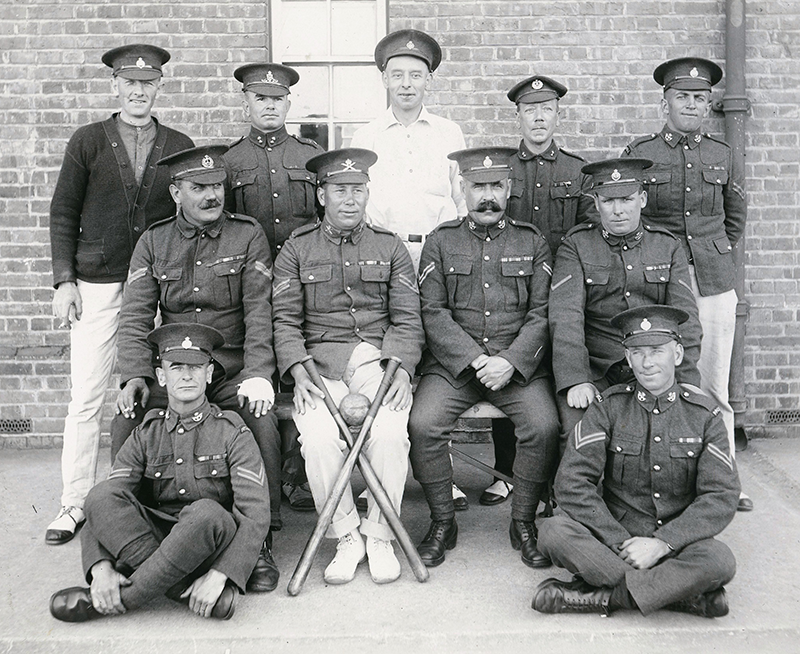 |
RAT PIT BASEBALL TEAM 1922
L. Cpl. Dunlop, Cpl. Shrosbree, L. Cpl. Wrightson, L. Cpl. Fagg, Cpl. Ryan, Cpl. Cotterell, Cpl. McVie, Cpl. Macdonald, L. Cpl. Emmett, L. Cpl. Millar, Cpl. Branson |
1923
PPCLI TUG-O-WAR TEAM, VICTORIA, B.C., 1923
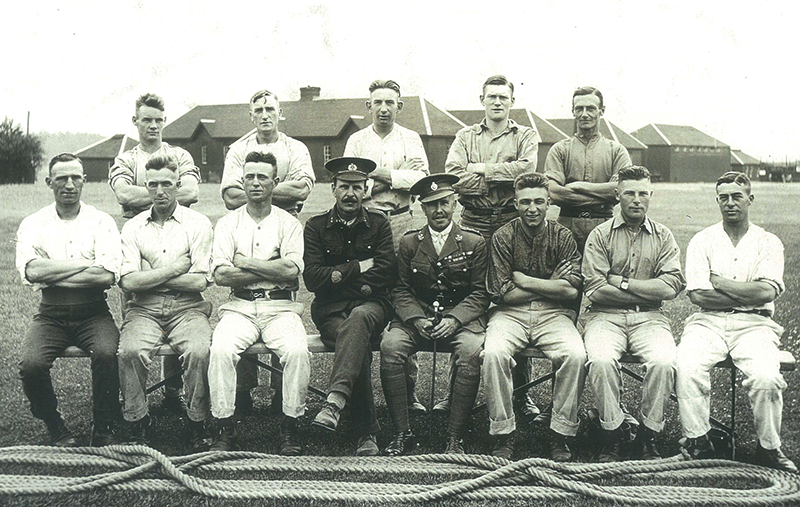 |
Top Row – Pte. Joiner C., Pte. McAllister A., Pte. Hutchison W., Sgt. Wallace,
J.W.A., Sgt. Henry C.M.
Bottom Row – Pte. Armstrong A. DCM, MM, Pte. Wiltse L.M., Sgt. Watson J.L. DCM, MM, Q.M.S. Jones -Trainer, Capt. E.B. Underwood MC, DCM, Pte. Biss J.F.,
Pte. Scott A.H., Pte. McVie R. |
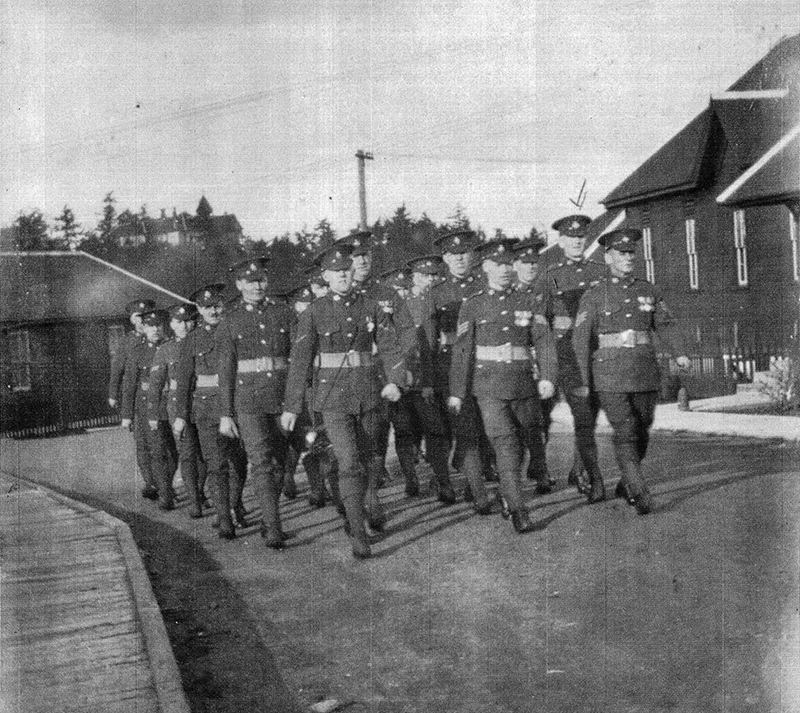 |
| B Company PPCLI Work Point Barracks Marching in Front of Building 1004 - 1923 |
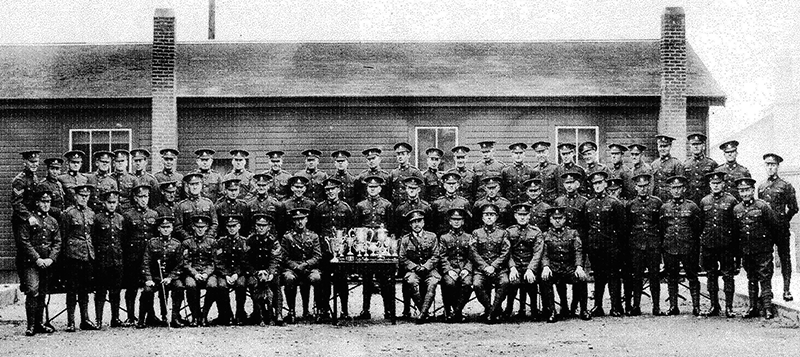 |
| B Company and Shooting Trophies - 1923 |
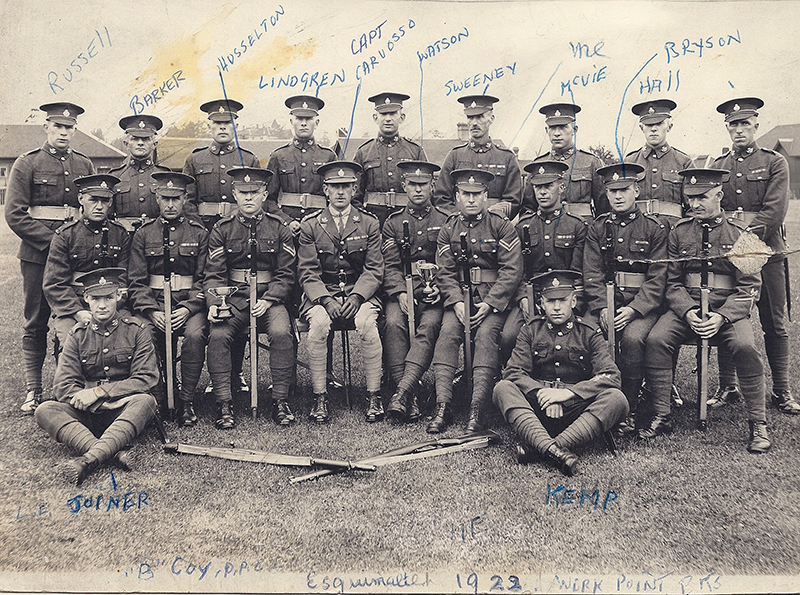 |
| B Company Demonstration Team – 1923 |
COLONIST
March 15, 1923 (19)
GUN PRACTICE FROM BLACK ROCK BATTERY
It is notified for information that practice from the 12 – pr. Q.F. Black Rock Battery will take place on the dates mentioned hereunder:
Monday, 19th inst., at 2 p.m. — 1-inch aiming rifle practice. Arc of fire from Macaulay Point to Albert Head. Safety limit, 3,500 yards.
Tuesday, 20th inst., at 2 p.m., — Twenty rounds 12-pr. Q.F. Full charge. Arc of fire from Macaulay Point to Albert Head. Safety limit, 6,600 yards.
COLONIST
May 30, 1923 (6)
GOING INTO CAMP
Canadian Scottish Holding Meeting of Members on Thursday to Make Arrangements
The 1st Battalion (16th Bn., C.E.F.) the Canadian Scottish Regiment, will go into camp on Friday at Macaulay Plain. The going into camp of a militia battalion always appeals to the members and the period under canvas compensates in no small measure for the monotony of week evening drills in the armoury.
The Canadian Scottish with its splendid record appeals to the young man who wishes to take a course in military training, and the approaching camp is a special inducement for becoming identified with the battalion. Extra orders have been issued relative to the camp which reads as follows:
“All members of the unit who intend taking part in the Regimental Camp at Macaulay Plain, commencing on Friday next, June 1, will assemble at the Drill Hall, Bay Street, on Thursday next, May 31, at 8:30 p.m., to discuss the final arrangements. Dress: Plain clothes.
COLONIST
June 14, 1923
DISTRICT ORDERS FOR THE PRESENT WEEK
By Colonel Commandant (Hon. Brigadier-General) J.M. Ross, C.M.G., D.S.O., Commanding Military District No. 11.
Victoria, B.C. June 14, 1923.
General Staff
Board of Equitation – A board of equitation, composed as under, assembled at 10 a.m. June 9, 1923, Macaulay Plain, Esquimalt, B.C., for the purpose of examining officers who attended the R.C.A.S.C. School, Esquimalt, B.C., from 28 – 5 – 23 to 9 – 6 – 23.
President, Major F.B. Eaton, R.C.A.S.C.; member, Lieut. And Brevet Captain H. Westmorland, R.C.A.S.C. Proceedings in triplicate will be forwarded to the General Staff Officer, M.D. No. 11.
Administrative Staff
Allowance in Lieu of Rations: — Authority is granted the undermentioned to draw allowance in lieu of rations with effect from 1 – 7 – 23: Pte. W. Robinson, R.C.A.S.C.
Water Supply, Heals Rifle Range — It has been brought to the notice of these headquarters that whilst units are in camp at Heals Range men have bathed in the Durrance Lake. This lake is a source of supply, the water being piped from there by the B.C. Electric Co. It is from this pipeline that water is laid on to Heals Range. All ranks are therefore notified that bathing in the Durrance Lake is prohibited on that account.
H.C. GREER
Lieut.-Col. A.A. and Q.M.G., M.D. No. 11.
COLONIST
July 15, 1923 (9)
CHURCH PARADE
At St. Paul’s Royal Naval Station and Garrison Church, Esquimalt, there will be Holy Communion at 8 a.m., while at 10:30 a.m. a parade of parties from H.M.S. Curlew and H.M.C.S. Patrician. The morning service will be followed by the Holy Communion. At 7 p.m. there will be the regular evensong.
COLONIST
December 9, 1923 (1)
DEATH SUMMONS MAJOR C.T. DUPONT
Famous Horeseman and Soldier of Early Days Dies at Age of Eighty-Six
Fifty Year Resident of City – Organized Artillery Here at Time of Russian Scare
Was One of Vancouver Townsite’s Original Owners
MAJOR CHARLES THOMAS DUPONT, for fifty years a resident of Victoria, died last night at 9 o’clock at his residence “Mount Eden,” Rock Bay Street. He had been ailing for a month or more, and this fact, together with his great age, paved the way for the sad tidings of his death to some extent, although to the firm friends of half a century’s associations in the city and Province his passing must always have come, whatever the circumstances, as a grievous surprise.
Although of late years little had been seen of Major Dupont about the city, in his younger days he was a leading figure in Victoria, and, indeed, in the Province. Born in Quebec on September 26, 1837, he came in his early thirties to the Pacific Coast, reaching Victoria in 1872 and making this city his permanent residence thereafter. It was as a member of a commission sent out by the Dominion Government from Ottawa for the purpose of studying the natural resources of the coast that he came west. When the work of this body was completed, he decided to stay in Victoria instead of returning to Quebec. He became collector of Island Revenue, and held that post until his superannuation many years afterwards.
MILITIA COMMANDER
In his native Quebec, Major Dupont had been long interested in militia work, and it was not surprising, therefore, that he brought his soldiering enthusiasm to Victoria with him Gathering a few ardent spirits about him, he organized the old Victoria Garrison Artillery during the memorable days when trouble with Russia was brewing and it was difficult to feel that the big bear of the North might sink his claws in Canada’s Pacific Province. Major Dupont was the commanding officer of this unit on its formation. After the Russian scare had passed into the domain of history, he retained all his military enthusiasm and shortly afterwards when the artillery was reorganized as a Provincial force, The British Columbia Brigade of Garrison Artillery, with companies at Victoria and New Westminster, was appointed commander of the Victoria unit. This was the forerunner of the present 5th regiment, C.G.A.
His business associations were of a pioneering character. He was a prominent member of the Victoria syndicate, headed by the Openheimer Brothers, Dr. I.W. Powell, Mr. F.J. Barnard and other leading men of early days, long since dead, which had possession of the land that is now covered by the city of Vancouver. The property was sold by the syndicate to the Canadian Pacific Railway when that company pushed its way over the mountains and down to the coast.
BROUGHT TRAM CARS
When tram cars first appeared on the streets of Victoria, Major Dupont was one of the organizers of the company, the Victoria Street Railway Company. He was subsequently president of that organization, and retained interest in it until its conversion, a long period later, into the B.C.E.R. of the present day.
When old-time residents of the city and the district will recall most readily in connection with Major Dupont, however, is his famous huntsmanship. He was a lover of horseflesh and a splendid rider. With his grey horse he was known everywhere about the countryside and on Empire Days in the city, he was a leading figure in the race meets at Beacon Hill, when amateur riders competed in furious races about the track. He was a capable man in the saddle, jumped fences like a two-year-old, and led the pack in the paper chases of thirty and thirty-five years ago, held by the one-time Victoria Hunt Club. His interest in equestrian matters was exceeded only by the tremendous energy he brought to bear on the militia activities of the city.
He was twice married, the first ceremony taking place in the East. He was bereft of his first wife about fifteen years ago. Later he married Miss Wilmot of Victoria. In addition to Mrs. Dupont, he is survived by one son, Charles, a lad of 12 or 13 years and by more distant relatives here. Mrs. F.B. Pemberton is a niece. The funeral will be private. It is requested that no flowers be sent.
For researchers, he is buried at Ross Bay Cemetery, A-35-W32. Also Margaret Jessie (1903) A-35b 36 E 31 and Mary Louisa (1926) A-36 W 32. Major Dupont’s biography is held in the “Oak Bay Chronicles,” hosted by Peter Grant, “Charles Dupont.” Please see the British Colonist July 23, 1922 (18 – 19) for more on his militia days here in Victoria.
1924
WORK POINT BARRACKS
1924
The following letter is determined to have been written in 1924 to a PPCLI soldier in “B” Company at Work Point Barracks. It could be titled “Ad Finem.”
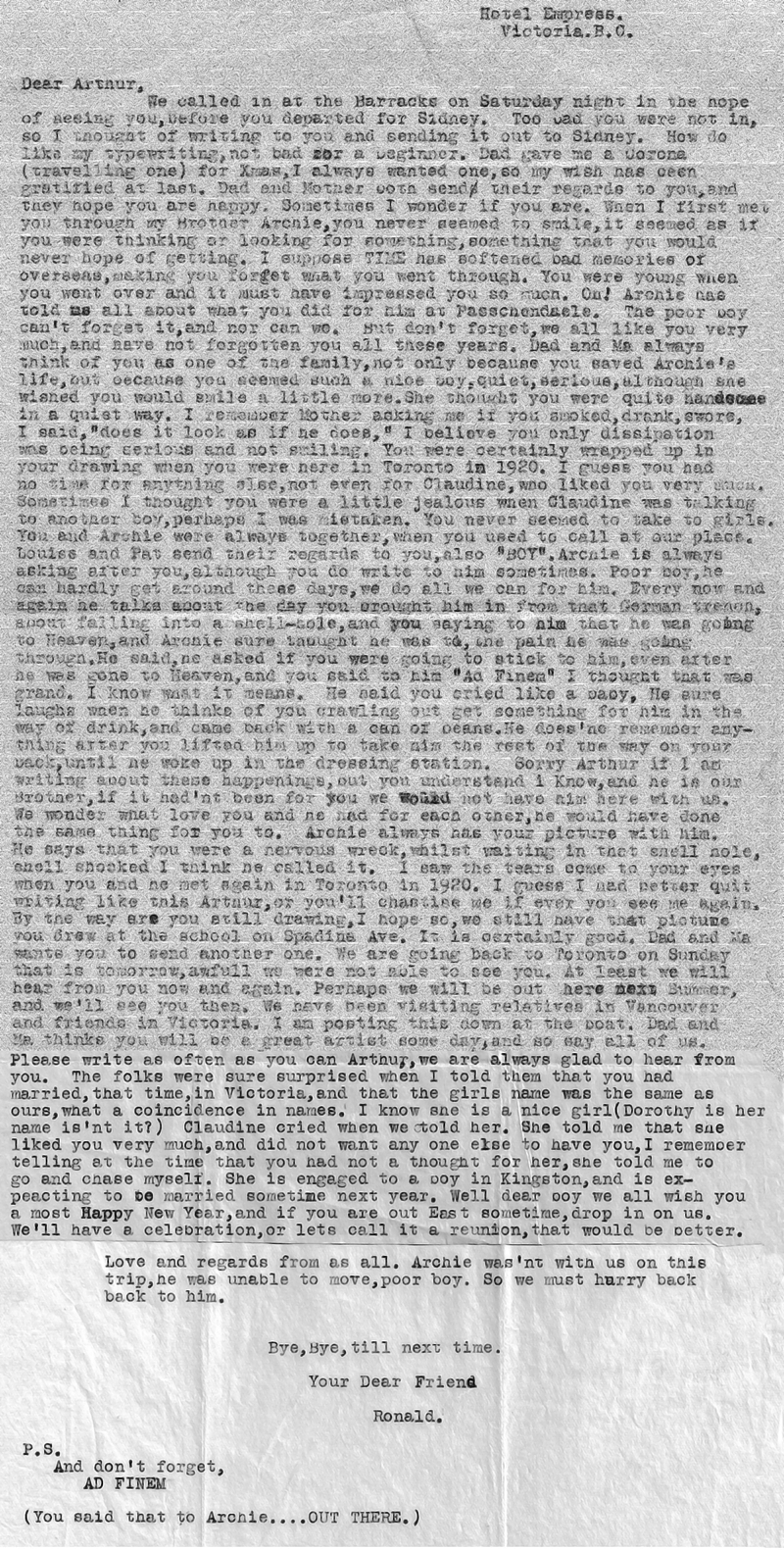 |
| Ad Finem |
Daily Colonist
January 18, 1924
Do You Remember
When John Doyle, a deserter from Work Point Barracks, returned from Seattle and gave himself up to the military authorities, explaining that the “dear old Union Jack was abused in Seattle more than he could stand”, and that he would rather be a deserter here than free there ? C.O.L.
Way back in 1878 when the Turkish trouble led to the terrible Russian war scare at Victoria, made doubly uncertain by the organization of the Fenians in the United States to launch a drive against Canada ? Many people, fearful of the Vladivostok fleet of the Russians, drew their money from the banks and sent it to the United States, while the men of the city prepared to meet the enemy, who never came, with the old muzzle loading rifles of the Hudson’s Bay Company. F.B.C.
When the collier Barnard Castle, laden with 2,300 tons of coal, from Nanaimo for San Francisco, struck Race Rocks and was beached in the passage between the Race and Rocky Point, there becoming a total loss. (November 23, 1886) R.
When Mr. Steve Jones had a new bus built by Mr. William Mable for the Dominion Hotel, the largest bus on the Pacific Coast, and crowds of admiring townspeople collected daily at his coach house to inspect it? (August, 1901) B.F.
When the “Iron Chink” was introduced into the canneries for the first time and Chinese hands in the Cleeve cannery threw down their knives, declaring the machine would have to go or they would? The iron man was shut down for the time being, but in later seasons was brought back as it came to realize that he could do what few others could – compete with the Chinese successfully. O.L.
Two of the three obsolete 6 inch disappearing guns at Fort Macaulay were replaced by two Quick Firing naval guns, this was referred to as a Close Harbor Defence role, the replaced guns were considered to be “in reserve”.
In 1924, 5 Company, R.C.G.A. was renamed 5 Heavy Battery R.C.A., they continued to reside in the brick barracks at Work Point and spent summers training at Fort Rodd Hill.
March 28, 1924
Remember When
When the old Marine Hospital stood on the old Songhees reserve in the 80’s and how, although there were often a dozen or more sailor patients, there were no nurses to look after them, only the old couple, who nursed, cooked and did everything else necessary. E.H.F.
November 14, 1924
FOUNDER OF NAVAL COLLEGE BURIED
Impressive Scene Witnessed at the Funeral Yesterday of
Commander E.A. E. Nixon, R.N.
The great esteem in which the late Commander Edward A.E. Nixon, R.N., (retired) was held by the service to which he belonged as well as by the wide circle of his personal friends and acquaintances in all walks of life was testified to in the big attendance at his funeral yesterday afternoon from the little naval church of St. Paul’s, Esquimalt. The edifice was crowded and a long cortege followed the remains from there to the Naval cemetery, Esquimalt, where interment took place.
The body was brought from the family residence, Wilkinson Road, Colquitz; early in the afternoon, pallbearers accompanying the remains to the church, where a firing party awaited the arrival of the little cortege. The impressive rites in the church were taken by Rt. Rev. C. de V. Schofield, Bishop of Columbia, assisted by Rev. F.C. Chapman, rector of St. Paul’s. The organist played the funeral march, and the congregation joined in the singing of two hymns.
On Gun Carriage
The coffin after the burial service in the church was placed on a gun carriage for conveyance to the cemetery, the cocked hat and sword of Commander Nixon resting on the Union Jack. The procession was led by a firing party of twenty five seamen on charge of Lieut. Hart, and a further thirty or forty men acted as a team for the gun carriage bearing the coffin, and beside which the pall bearers walked. There followed the chief mourners, Commander and Mrs. Morres, of Cowichan; and Commander Beard, Mrs. Nixon and her two children; and about thirty of the chief and petty officers from the Esquimalt Naval Station, carrying the numerous wreaths and other floral tributes. At the cemetery Rev. Mr. Chapman took the committal service.
The Pallbearers
The pallbearers were Eng. Lieut. Commander G.P. Clarke, Lieut. Oland, Paymaster Cossette, Eng. Lieut. Commander Stephens, Lieut. Gow, and Lieut. Godfrey
His Honor the Lieutenant Governor was represented by Major Selden Humphreys and Mr. H.J. S. Muskett, Brigadier General Ross, G.O.C., and Major Cobbett represented Military District No. 11. Others attending the rites included Lieut. Grant and Lieut. Beach, members of the staff of the Naval College here, closed in 1922, and of which Commander Nixon was the founder and head during the whole period of its existence. Mr. George Phillips and the whole of the Esquimalt dockyard staff attended, and the Canadian Mounted Police were represented, also the Navy League, by P.A. Raynor, and the Esquimalt Sailor’s Club, by Mrs. Ranns, and Yarrows, by Messrs. N. Yarrow, Izard and Robinson. Capt. Backler, under whom Commander Nixon served as a midshipman in the Brittania, was among the congregation at the church, also Commodore Barnes.
The Sea Cadets Band marched in advance of the cortege as it left the church, playing the funeral march.
FORT RODD HILL
1924
This photo is of the ROYAL SCHOOL of INFANTRY taken at Fort Rodd Hill. The school was headquartered at Work Point Barracks at the time and utilized Fort Rodd Hill for training.
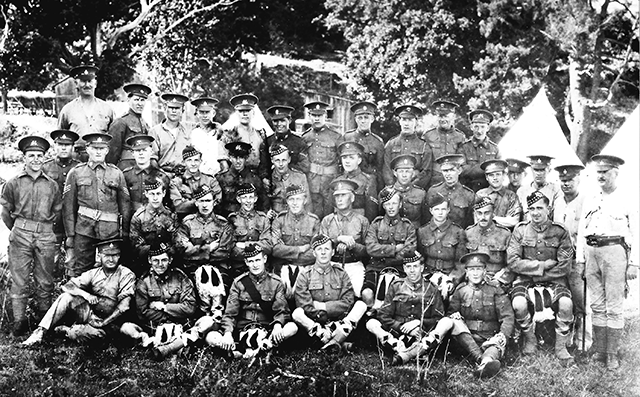 |
Royal School of Infantry Rodd Hill 1924
... run cursor over photo to zoom image ... |
1925
 |
B Company PPCLI Work Point Barracks
... run cursor over photo to zoom image ... |
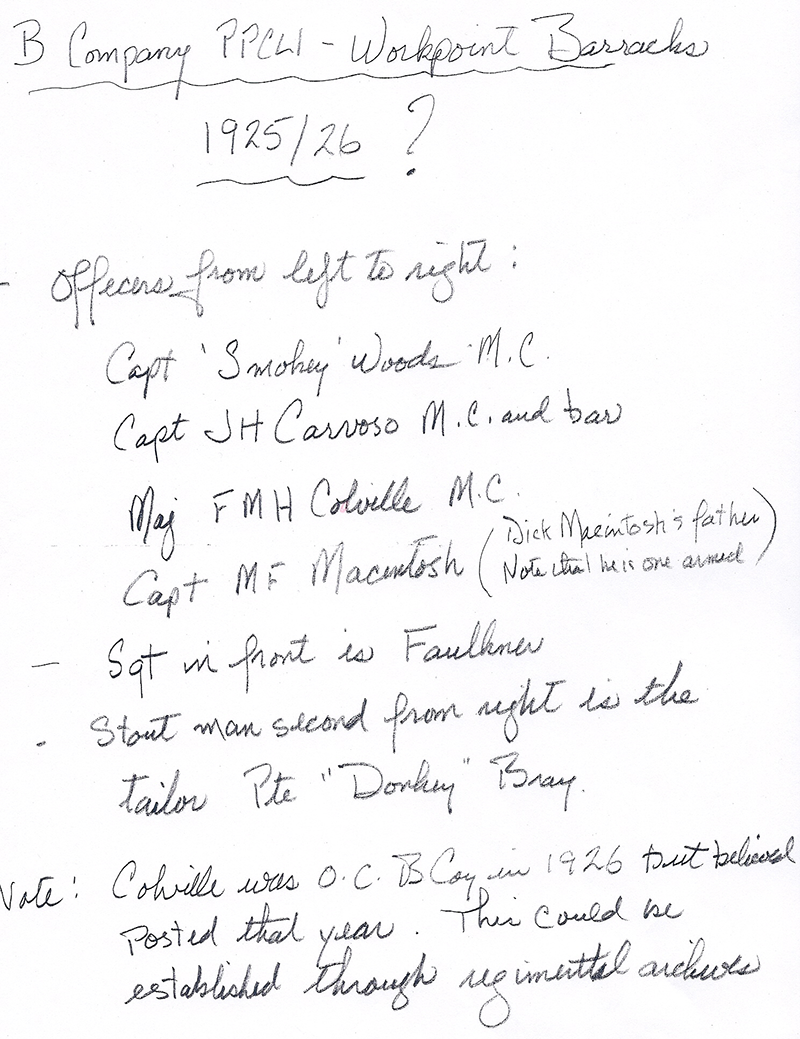 |
| B Company Names Associated With the Above Photo |
ESQUIMALT GARRISON RIFLE TEAM, 1925
(Including 5 Man Team – Winners of 7 Trophies, Ottawa, 1925)
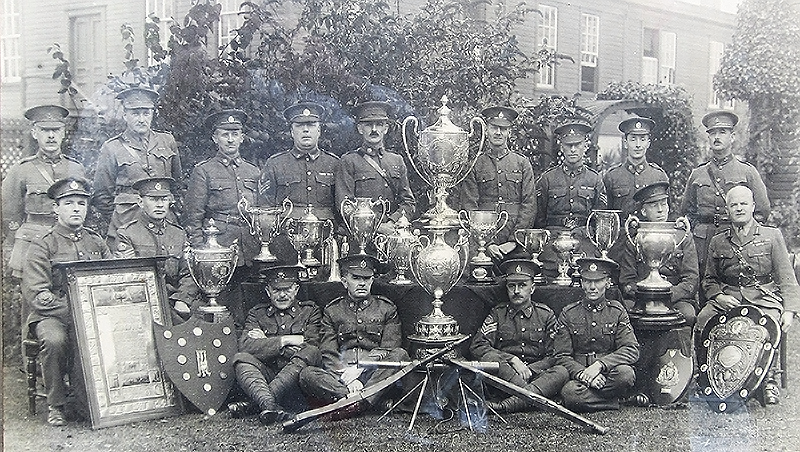 |
Esquimalt Garrison Rifle Team 1925
Work Point Barracks – Fort Rodd Hill Collection
... run cursor over photo to zoom image ... |
Back Row: S.M. Read, Maj. H.R.N. Cobbett, Q.M.S. J. Kennedy, Sgt. T.E. Fairman, S.M. H. Durling, Pte. C.M. Henry, Sgt. H. Nielson, Q.M.S. A.E. Evans, Mr. Gr. H. Collings.
Centre Row: Q.M.S. J.H.C. Murray, S.Sgt. W.B. McKay, S.M. W.H. Ruffell, Brig. Gen. J.M. Ross CMG, DSO.
Front Row: Pte. A.R. Hooper, Pte. E.H. Shrosbree, Sgt. W.H. Wood, L.Cpl. H.W. Burton.
5th (BC) Regiment Canadian Garrison Artillery and Early Defence of B.C. Coast
Historical Record by Lieut. Colonel F.A. Robertson
January 31, 1925.
PREFACE
The Fifth (B.C.) Regiment, Canadian Garrison Artillery, with headquarters in Victoria, has the honor of being the oldest Militia Unit now existing in Western Canada. Although the Canadian Militia List shows that this Regiment was organized in October 12, 1883, it should be remembered that the organization of the Regiment was an amalgamation of several military units which had been formed many years earlier. The various units which were united in a single Regiment in 1883 included: The Victoria Battery, formed in 1878; the Seymour Battery of New Westminster, formed as a Voluntary Company in1866; and one company of Victoria Rifles, first organized as a Volunteer Unit in 1862.
Citizens of Victoria have reason to be proud of their Artillery Regiment which during the last sixty three years has included in its membership a great number of the most prominent and respected men in the District, and has had for Commanding Officers such distinguished men as General Sir Arthur Currie; Lieut. Col. E.G. Prior, late Governor General of British Columbia; Lieut. Col. F.B. Gregory, Judge of the Supreme Court; and other men of note in civilian life.
There are still a number of men living who were actively identified with military activities in the early days, and with the valuable assistance of some of these “old timers” I have spent much of my spare time during the last five years in collecting and arranging the material for this historical record in order that the traditions of the Regiment may be preserved for future generations.
As the early history of the Regiment dates back to the pioneer days on this coast, and was closely identified with the history of other military units which are now non-existent, the story would not be complete without a brief review of the various organizations comprising our defences on this coast from the time when Victoria was nothing more than a fort of the Hudson’s bay Company.
Three copies of this record are being typewritten and bound in book form one for the Officer’s Mess, 5th Regiment, C.G.A., one for the Provincial Archives and a third copy I shall keep in my possession.
In presenting a copy to the Officer’s Mess as a souvenir on my retirement as Commanding Officer I wish every success to those who remain to carry on the good work. Although the Militia should train men to fight, the chief importance of this training is that it ensures to a certain extent a guarantee for peace. To be prepared for any eventuality is often the best means of preventing its occurrence. It is hoped, therefore, that the story of the Regiment as told in this book may be an inspiration to present and future officers to hold the standard high and always ensure for the old “5th” a degree of efficiency in keeping with the Regimental motto “Nunqua non Paratus.”
(SND) F.A. Robertson Lt. Col.
Victoria, B.C. January 31st, 1925.
Presented to the Officer’s Mess, 5th Regiment., C.G.A.
COLONIST
April 25, 1925 (1)
WAR MEMORIAL DUE TO REACH VICTORIA WITHIN SIX WEEKS
The Victoria War Memorial statue will reach Victoria in about six weeks’ time, the directing committee announced yesterday, after learning that it will leave England in the hold of the Canadian Pioneer on April 30. Under the chairman-ship of Mr. Lindley Crease, a meeting of the committee was held yesterday to discuss plans for the unveiling, the date of which will be announced later.
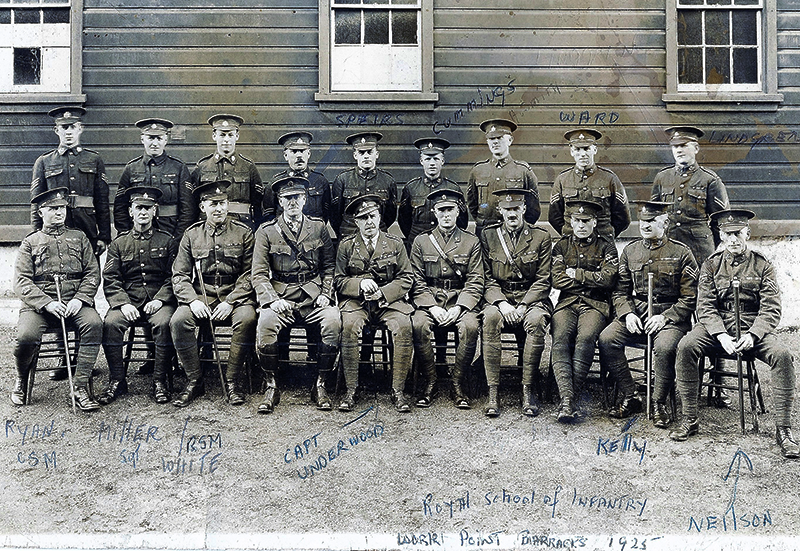 |
| Royal School of Infantry Work Point Barracks - 1925 |
1926
Smith Street was renamed “Peters” Street after Canadian born James Peters, a prominent army officer who first came to Victoria as a Major with “C” Battery in 1887, after serving in the Northwest Rebellion. He was known for his pioneering in photography. Colonel Peters retired in 1910, was active in the local community and elected to the first Esquimalt Council in 1912. He died at his home at 423 Peters Street in May 1927 which he had built in 1899 and named “Ashburn.” The house was demolished in 1947. See September 24, 1899. There is a profile of Colonel Peters on the CFB Esquimalt Museum web site.
The 7th fairway of the Macaulay Point Golf Links ran in front of the house parallel to Peters Street.
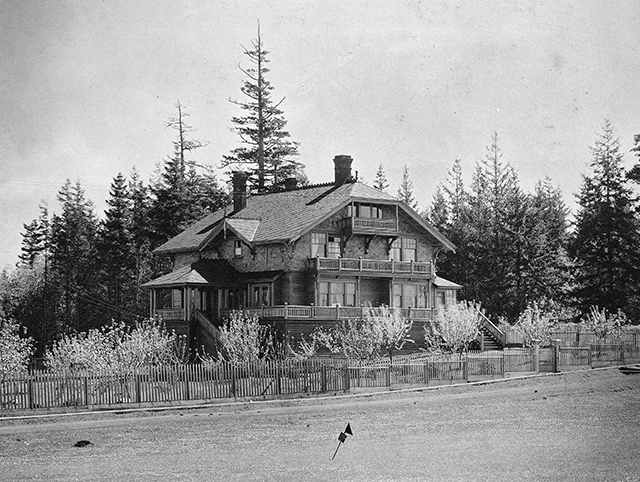 |
| ASHBURN - 423 Peters Street, formerly Smith Street |
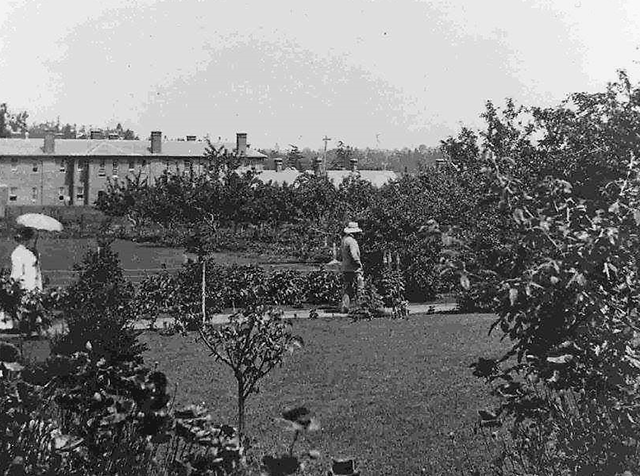 |
| ASHBURN - back yard |
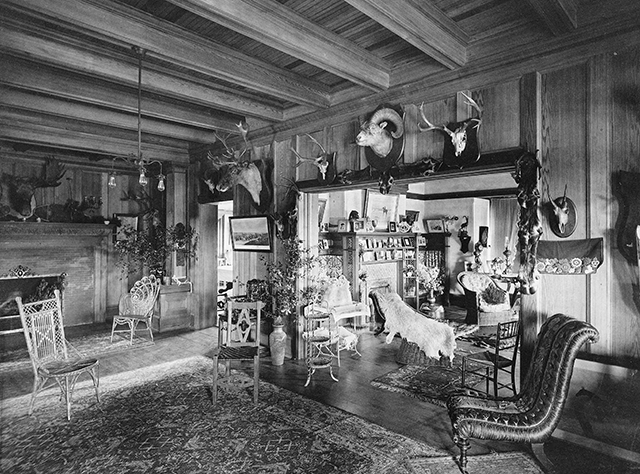 |
| ASHBURN - interior |
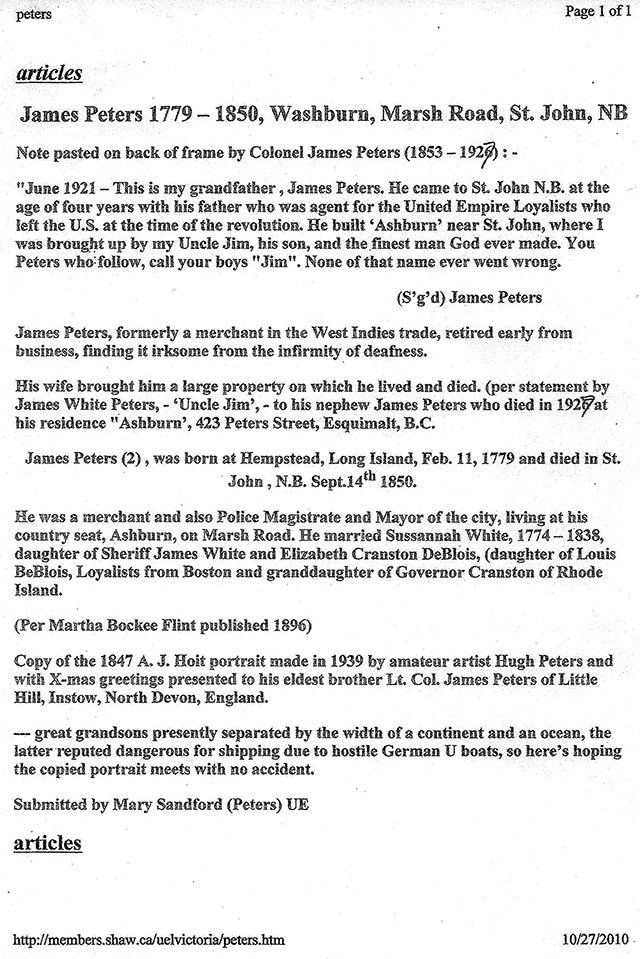 |
| ASHBURN HISTORY |
Photos "ASHBURN" Courtesy Colin MacLock (Mary Sanford Collection).
COLONIST
April 9, 1926 (10)
NEW GAME MAKING GREAT WAY TOWARDS POPULARITY
INDOOR BASEBALL GAINING NEW ADHERANTS EVERY SEASON IN VICTORIA
WORK POINT GARRISON FIRST TO INTRODUCE THE SPORT TO VICTORIA
A game which has rapidly become popular in Victoria since its introduction here a few years ago is indoor baseball. Why the name indoor baseball is still adhered to is somewhat of a mystery, seeing that it is played almost entirely out-of-doors, here at any rate, and it would seem that the name has been rather misleading in more than one way, as it has given the impression to many people who have never seen the game played, that it is a rather poor imitation of real baseball played on a real diamond.
As a matter of fact, “indoor” baseball is played, with a few slight differences in the rules and playing conditions, in much the same way as the baseball of the big leagues. Some of the differences are that the bases, instead of being ninety feet apart are only sixty-five feet apart, and a different and larger ball is used. Gloves are not worn in this game except by the catcher, and a smaller bat goes with the larger ball. The pitching varies from that or ordinary baseball in that the delivery must be made in a certain manner laid down in the regulations, which precludes an over-arm delivery.
Garrison Started Things
To the Garrison at Work Point Barracks goes the credit of introducing the game to this city, and for quite a few seasons the Tommies had what was known as the Garrison League before any other league was formed. I Esquimalt the civilian population became interested and in the year 1923 it was suggested that a city league be formed. Interested parties from the various clubs met and it was finally decided to form a city league, which at that time was known as the city Indoor Baseball League. Things went along quite nicely and interest began to grow and the following year saw the league with eight teams playing under the name of the Victoria and District Indoor Baseball League.
Last season no less than ten teams competed for the city championship, which goes to show the increasing popularity of the game, The Y.M.C.A. won the Clearihue Cup and medals after a hard-fought play-off series with the Hillcrests. Some of the best senior ball players in the city were seen in action last year with the Victoria and District Indoor Baseball League teams, and this should convince the most skeptic fan that the game is much harder than the average person is apt to think.
Expect Banner Season
This year the executive of the Victoria and District Indoor Baseball League are looking forward to a banner year. New teams have already made known their intention of casting their lot with the young league. It is expected that no less than fifteen teams will be seen in action this season competing for the city championship. Any interested club or party can get all the information by writing S. Thomas, 1036 Hillside Avenue.
The annual general meeting of the league for the coming season will be held in the near future and any club wishing to cast its lot with the Indoor Baseball League can do so by attending this meeting, notification of which will appear in the press.
COLONIST
April 21, 1926 (10)
INDOOR BALL LEAGUE WILL MEET TONIGHT
NAME OF ORGANIZATION WILL PROBABLY BE CHANGED
INCREASED NUMBER OF CLUBS ENTERING
Tonight, at 8 o’clock, in the Y.M.C.A., delegates of the Victoria and District Indoor Baseball League will meet with the chances that this will be the last meeting of the league under that name, as suggestions have been made for a more suitable and less misleading name for the sport, and just what name will be taken will not be known until after tonight’s gathering.
Formed in the year 1923, the Indoor Baseball League has made great strides towards popularity, until today no less than ten teams have been participating in the city championship. This season, however, it is expected that at least six new clubs will cast their lot with this young ball league. All of last year’s teams have signified their intention of competing again this season. The clubs which played last season were: Garrison A, Garrison B, Hillcrests, Esquimalt, Foul Bay, Y.M.C.A., Navy, Priors, Onwegoes and Tillicums. This year the Sons of England, Sons of Canada, C.P.R., Plimley and Ritchie, U.T.C., Wilson Bros., Ross Bay, James Island, Kirkhams and C.P.S., it is expected will enter the indoor baseball loop. Representatives from the organizations are specially requested to attend tonight’s meeting, as it is the intention of the league to get under way as soon as possible, and the executive requests that every club be represented. Although no date is set for the closing of entries, the clubs will help a great deal by filing their entry tonight.
SOFTBALL ENTRIES MUST BE IN TODAY
SCHEDULE WILL BE DRAWN UP AT MEETING TONIGHT IN Y.M.C.A.
TWENTY TEAMS EXPECTED TO ENTER
Teams intending to enter the Victoria and District oft Ball League are reminded that today is the last date for the acceptance of entries. Tonight at 8 p.m. in the Y.M.C.A., the league delegates will meet, when entries will be accepted and the schedule for the season will be drawn up. Last year the league was a success, and every season it is gaining popularity, until this year it is expected that upwards of twenty teams will play in this newly-formed league.
The Clearihue Cup, donated by Alderman Clearihue, is the perpetual trophy for the league champions. In the first season the Hillcrests copped the silverware, while last year the Y.M.C.A. won the championship after a hard-fought series with the former club, Foul Bay, who made their initial appearance last year, won the B section of the schedule but lost the second half of the schedule to the Y.M.C.A. Clubs are again reminded to be on hand at 8 o’clock tonight at the Y.M.C.A.
Originally the Garrison games were played in Work Point Barracks and at Macaulay Point while the Navy hosted games at the Canteen Road grounds. The league name was changed to the Victoria and District Softball League prior to the start of the 1926 season, thus the forerunner of Softball/Fastball in this area. The best team of course was the VICTORIA BATE FASTBALL CLUB from 1968 to 1977, with due credit to Herb and Lil Bate and the club team they formed which was so successful and reached a world class level through so much dedication by all involved.
“When the club came to a fork in the road, they took it.”
COLONIST
April 28, 1926
SOFTBALL LEAGUE DRAWING BIG ENTRY
EVERYTHING POINTING TO EVEN MORE SUCCESSFUL SEASON THAN LAST
OFFICERS FOR YEAR ELECTED
The annual general meeting of the Victoria and District Softball League took place last night at the Y.M.C.A. There was a large turnout of delegates from the different clubs composing the league and several delegates from new clubs.
The 1925 season was the most successful since the league’s inauguration and this year the everything points to a more successful season. Last season there were ten teams playing and for this year there will be an increase of eight to ten teams. All entries for this season must be in by April 28, when the next meeting takes place at the Y.M.C.A. At this meeting the schedule will be drawn so as to allow the first games to be played during the first week of May. The league teams were well supported by the public last season, and for this season the fans will see much better games.
THE OFFICERS
The election of officers took place with the following results: Hon. Patron, His Honour Lieut. Gov. R. Bruce; honorable president, J. Clearihue; honorary vice-presidents, Hon. W. C. Nichol, R.H. Pooley, MPP, Hon. John Oliver, J Virtue, Commander Nelles, S.N.O., RCN; H. Maynard, past vice-president; Dr. A. Poyntz, president; Percy Payne, vice president; Steve Redgrave, secretary-treasurer; Sidney Thomas.
COLONIST
April 29, 1926
SOFTBALL LEAGUE WILL OPEN TONIGHT
EIGHTEEN TEAMS PLAYING IN FIRST GAMES OF SEASON IN “A” AND “B” SECTIONS
Eighteen teams of the Victoria and District Soft Ball League will make their initial bow to the public tonight at 6:30 sharp. 4 games will be played in the A section and 5 in the B section. The schedule for tonight’s fixtures is a s follows:
Foul Bay vs Sons of England, at Foul Bay; Hillcrests vs Esquimalt, at Macaulay Point; Navy vs Tillicums, at Canteen Grounds; Y.M.C.A. A vs Onwegos, at Central Park.
The draw for the first round in the B section is as follows: Andreans vs Wilson Bros., Beacon Hill; Cameron Lumber Company vs Lemon-Gonnason Lumber Company, Victoria West Park; Y.M.C.A. B vs Bryant’s Bluebirds, Central Park; Normal School vs B.A. Paint Company, at Normal School; Plimley and Ritchie vs Harris & Smith, Beacon Hill Cricket Ground; Hudson’s Bay a bye. The first mentioned being the home team.
STRONG LINE-UPS
It is too early in the season to predict just which will be the feature game, but according to the club managers they all have good line-ups. The game at Macaulay Point between the Hillcrests and Esquimalt should be interesting. Last year the Hillmen were in the finals for the league championship with the Y.M.C.A., the latter team winning the championship after a hard-fought series. This season the Hillcrests have a strong team and tonight they will give Esquimalt a real battle. The Dockers are a much younger team, but are carrying some really good players, and it is expected that before the first half of the schedule terminates this team will be well up in the league standings.
The Y.M.C.A., who last year copped the title, are billed to meet Onwegos at Central Park. The Y.M.C.A. have a snappy team, capable of dishing up a good brand of ball. Foul Bay, who won the B section of the league schedule last season, are billed to meet the Sons of England at Foul Bay. The former club are all young players with a good knowledge of the game, and tonight they will be out to lower the colors of the Englishmen who are making their initial bow in the softball league. The other game in the A section will be between the Navy and the Tillicums at the Canteen grounds. The Clubmen has a young team that has been showing great form in practice matches and tonight they will journey to the Navy grounds to try and hand the Tars a defeat in the first league game of the season.
ALL NEW ENTRIES
Very little can be said of the teams in the B section as they are all new entries. However, their managers report that they have some good material lined up and these games should be close. With so many new teams entered this year it only goes to show that the Soft Ball League is meeting with more success each year. Last season ten teams competed for the Clearihue Cup and the league championship; this season no less than nineteen teams will participate. Once again team managers are reminded to send their name and address to the league secretary, while home clubs are reminded that they must send the score sheet to the secretary of the league in order that the league standing can be kept up to date.
GUNNERS OF CANADA
1926
BEFORE THE SECOND WORLD WAR
This 1926 photograph shows members of the 2nd A.A. Section, 5th (BC) Regiment C.G.A., with a First World War 13 – pounder 9 – cwt, anti-aircraft gun, which has been mounted on an improvised platform at Work Point Barracks, Esquimalt, by Lt. J.G. Rycroft. The gun was later moved to Fort Macaulay and used for training well into the Second World War.
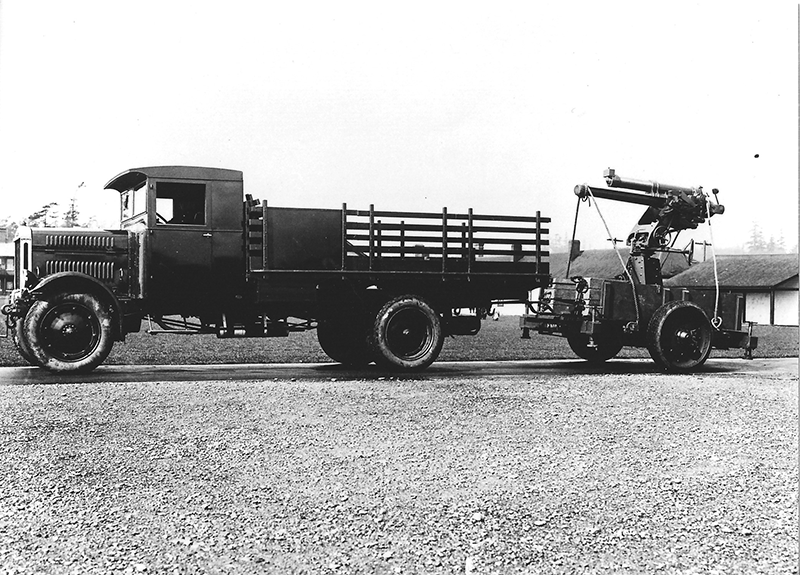 |
| 13 pdr QF AA Gun moved to Fort Macaulay |
1927
COLONIST
April 17, 1927 (4)
REMEMBER WHEN
When the Victoria Garrison Artillery was a well known military organization in Victoria, many of the young men of the day, some of whom are still with us, joining up, and meeting for drills and parades at the old drill hall on Menzies Street ? At the time I joined Captain Dupont, afterwards Major, was in command. This organization later was known as the B.C.R.G.A. (British Columbia Battery Garrison Artillery) and was humorously styled the Alphabetical Brigade.
BC Geographical Names Office
Wark Point adopted 20 March 1907 on Ottawa file OBF 0023, as identified in Walbran’s manuscript. Form of name changed to Work Point 5 April 1927, as had been labelled on Pemberton’s 1855 map Southeastern Districts of Vancouver Island, and on British Admiralty Chart 567, 1864. (Ottawa file OBF 0023)
Daily Colonist
May 8, 1927
COL. J. PETERS PASSES HERE AT RIPE AGE
In Charge of Artillery in Several Engagements During
Second Riel Rebellion in Northwest
LEAVES LENGTHY SERVICE RECORD
Was District Officer Commanding in Several Military Areas of
Dominion Prior to 1910
In the death yesterday of Col. James Peters, this district loses a distinguished officer, a first class sportsman and one who enjoyed popularity in a marked degree among all classes of the community where he had spent many years of an active life.
He had been in failing health for several weeks, and the end was not unexpected.
Born in September, 1853, at Saint John, N.B., he was the son of William Tyng Peters. His military career dated back to 1870 when he served as a bugler with the 62nd Saint John Fusiliers, when the active militia were called out during the second Fenian raid.
In 1872 he joined A Battery, R.C.A., at Kingston, and was given command of a company composed of detachments from A and B Battery, proceeding to Fort Garry to relieve troops of the expedition under Sir Garnet Wolseley, sent west to suppress the Riel Rebellion. The detachment was the first artillery to go to Fort Garry, and arrived via the Dawson route, just opened from Prince Arthur’s landing.
After five or six months at Fort Garry, as second in command to Major Taschereau, he returned east in charge of a party of invalided soldiers, and then reported at Kingston for qualification as an officer of the permanent corps of the R.C.A.
SECOND RIEL REBELLION
In 1881 he was appointed adjutant of the first Canadian artillery team to proceed to Shoeburyness, England. During the second Riel Rebellion of 1885 he commanded A Battery, R.C.A., in the actions at Fish Creek, Batoche and operations against Chief Big Bear’s band. For his services he was mentioned in dispatches. During that campaign he acted as correspondent for the Quebec Chronicle, and carried a cabinet camera with which he took many photographs, some of which appeared in the London News and the Graphic. These were the first photographs ever taken in action.
COMES TO COAST
He was given command of C Battery, R.G.A., on its formation in 1887 and brought it to British Columbia, and the first troops to cross Canada.
In 1888 he took the battery to the mouth of the Skeena River, landing at Fort Eastington, in connection with troubles with the Indians.
He remained in command of C Battery until it was withdrawn from British Columbia, when he was appointed District Officer Commanding in British Columbia. He remained in Victoria until the South African war, when he transferred to Toronto, relieving Col. W.B. Otter. He commanded in Montreal for a short time, and then was moved to London, Ontario, where he remained for eight years, being transferred back to this command in 1909. In the following year he was placed on the retired list, having completed thirty seven years of service with the Canadian Army.
MANY ACTIVITIES
Colonel Peters, after his retirement, resided near Work Point Barracks, at 463 Smith street. While in early years he took a great interest in rowing, horsemanship and hunting, of late years he had been known as an enthusiastic golfer and fisherman. He had gained many athletic trophies in his younger days, but his particular pride was a magnificent set of heads of moose, caribou and big game secured in hunting expeditions in New Brunswick, Eastern Quebec and in British Columbia. When the Esquimalt Council was established in 1912 he was one of the first councilors of the Township Municipality.
THE FAMILY
Colonel Peters married in September, 1876, Miss grace Hathaway, of Fredericton, N.B. He is survived by his widow and six children. They are Colonel James Peters, retired, of Bidefore, Devon, England; Mr. F.H. Peters, Surveyor General and Director of the Topographic Surveys, Ottawa; Mr. Hugh Peters, Assistant Engineer, Federal Department of Public Works, Victoria; Mrs. Grace Stewart, wife of Captain J.D. Stewart, R.N., retired, Camberley, England; Mrs. Olive Coulson, wife of F.L. Coulson, Toronto and Mrs. Gladys Bray, wife of Mr. R.R. Bray, Vancouver.
Two brothers and three sisters of Colonel Peters are as follows: Mr. F.W. Peters, Vancouver, and Mr. T.L. Peters, Winnipeg; Ms. Margaret Fletcher, Vancouver; Mrs. Charlotte Hanington, California, and Mrs. Susan Morse, Ottawa.
There will be a military funeral tomorrow afternoon, details of which were being arranged last evening. Interment will be made at the Naval Cemetery, Esquimalt.
COLONEL JAMES PETERS
The many excellent qualities of the late Colonel James Peters did not only become known to Victorians while he held the post of D.O.C. of Military District 11, or during his otherwise long and honorable association with the Esquimalt Garrison. He had mixed in many ways with the life of the community and wherever he was known it was as a sterling character. As D.O.C. he was extremely popular, and none the less efficient. The years of his administration at Work Point are still recalled with the highest satisfaction by all who served under him, and during those years, and ever since, throughout his residence at Esquimalt, he has been a loved figure.
Colonel Peters was a valuable resident of greater Victoria for he was always to be found on the side of progress. Even in later life, when his health had not been good, he had contrived to take a keen interest in the progress of this city and its surrounding Municipalities, as well as in the fortunes of the friends he had made; and his friends were many because his personality was an extremely likeable one. In a quiet way, for he never wished his good actions to be known, he has helped many people over little difficulties in their careers, either by advice or otherwise. In whatever way his life is viewed he will be missed by all who had the honor of his friendship, and by many others who knew and admired his genuine characteristics. The deepest sympathy will be extended to his relatives and to this the Colonist adds its tribute of sorrow.
May 10, 1927
Many Attend Funeral Rites of Col. J. Peters
The funeral of the late Co. James Peters took place from the residence, 423 Smith street, Esquimalt, at 2:30 o’clock yesterday. Rt. Rev. Bishop Schofield officiated, assisted by Rev. F. C. Chapman. A large attendance was present, including officers, non commissioned officers and men of Work point Barracks, who attended in a body. The remains were carried to the Naval Cemetery on a gun carriage covered with the Union Jack.
The firing party was in charge of Sergt. Watson, P.P.C.L.I., firing three volleys over the grave, and bugler Sergt. Bates sounded the “Last Post.”
The following acted as honorary pall bearers: Col. A.W. Jones, Lieut. General G.R. Poole, Lieut. Col. A.R. Hodgins, Mr. A.C. Plumerfelt, Mr. Dennis R. Harris, Col. George R. Barnes, Brig. General J.M. Ross, D.O.C., Col. W.J.H. Holmes, Senator G.H. Barnard, Major H.W. Niven, Mr. Justice W.A. Galliher, Mr. D.B.F. Bullen, Mr. P. Criddle, and Major A. Mulcahy. The following acted as active pall bearers: Sergt.P.H. Baxter, Master Gunner Michell, Staff Sergt. Willcox, Sergt. Major Bradley, Sergt. Kendrick and Sergt. Smith.
A 13 pounder, 9 hundred wt, anti aircraft gun was at Work Point Barracks in 1927. This gun was mounted on an improvised travelling platform by Lt. J.C. Rycroft.
 |
About 160 Officers, NCO’s and men of the PPCLI attended Sarcee Camp
in the summer of 1927.
... run cursor over photo to zoom image ... |
COLONIST
May 15, 1927 (4)
REMEMBER WHEN
When Deadman’s Island, off the Cameron Lumber Mills on the way to the George by water, was covered with trees and shrubbery, and in the trees were suspended the coffins of Indians ? It was this island that was always used as the rounding point for all boat races starting from the George on May 24 regattas.
COLONIST
May 22, 1927 (4)
REMEMBER WHEN
When big guns were mounted at several points at Beacon Hill, the excavations for which can still be seen ? One was near Finlayson Point, and on these guns the artillery boys used to drill. The handling of big guns in those days was real muscular work, and vastly heavier on the men than present day equipment.
July 8, 1927
COAST BRIGADE TO TRAIN SOON
Fifty-Fifth And Fifty-Sixth Heavy Batteries To Camp AT Fort Macaulay
Twelfth Siege Battery and Fifty-Eighth Battery Will Proceed to Sarcee Camp
The Fifty-fifth and Fifty-sixth Heavy Batteries of the Fifth British Columbia Coast Brigade will go into camp training at Fort Macaulay on Saturday, it was announced by Major Kirkpatrick-Crockett yesterday. Both companies have been undergoing a strenuous preliminary course, so that when they enter camp they will be applying their knowledge to the practical part of the training.
This year the Fifty-fifth Heavy Battery will endeavor to maintain its record of the past two years and make another cleanup of the Canadian Artillery Association competitions. This company has for the last two tears won the Governor General’s trophy and hopes to win it again this year. The fellow company, the Fifty-sixth Heavy Battery, however, has been training assidually in an endeavor to wrest the honors from the Fifty-fifth, so that there will be keen rivalry at the camp.
The Twelfth Siege Battery and Fifty-eighth Field Battery, of the Fifth British Columbia Coast Brigade, will proceed to Sarcee Camp for training on July 12, and, following this, the anti-aircraft section will go into camp, thus completing the training of the Brigade.
PPCLI “B” Company Daily Orders
October 5, 1927
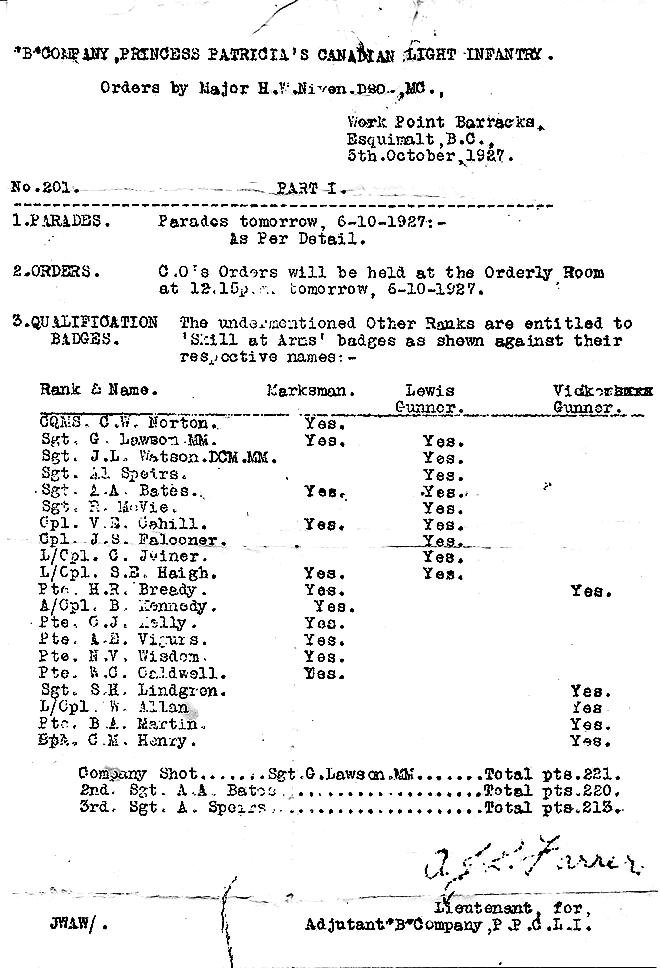 |
| B Company Daily Order 1927 |
... continued in 1928 ...
|

